Corporate Accounting: Equity, Cash Flow Statements and Comparative Analysis
VerifiedAdded on 2023/06/05
|25
|4769
|87
AI Summary
This document provides an analysis of equity, cash flow statements and comparative analysis of Vodafone PLC and SingTel Optus. It includes a detailed description of the components of owners’ equity and changes to these components over the years, comparative analysis of debt and equity position of two companies, and a comparative analysis of three broad categories of cash flows.
Contribute Materials
Your contribution can guide someone’s learning journey. Share your
documents today.
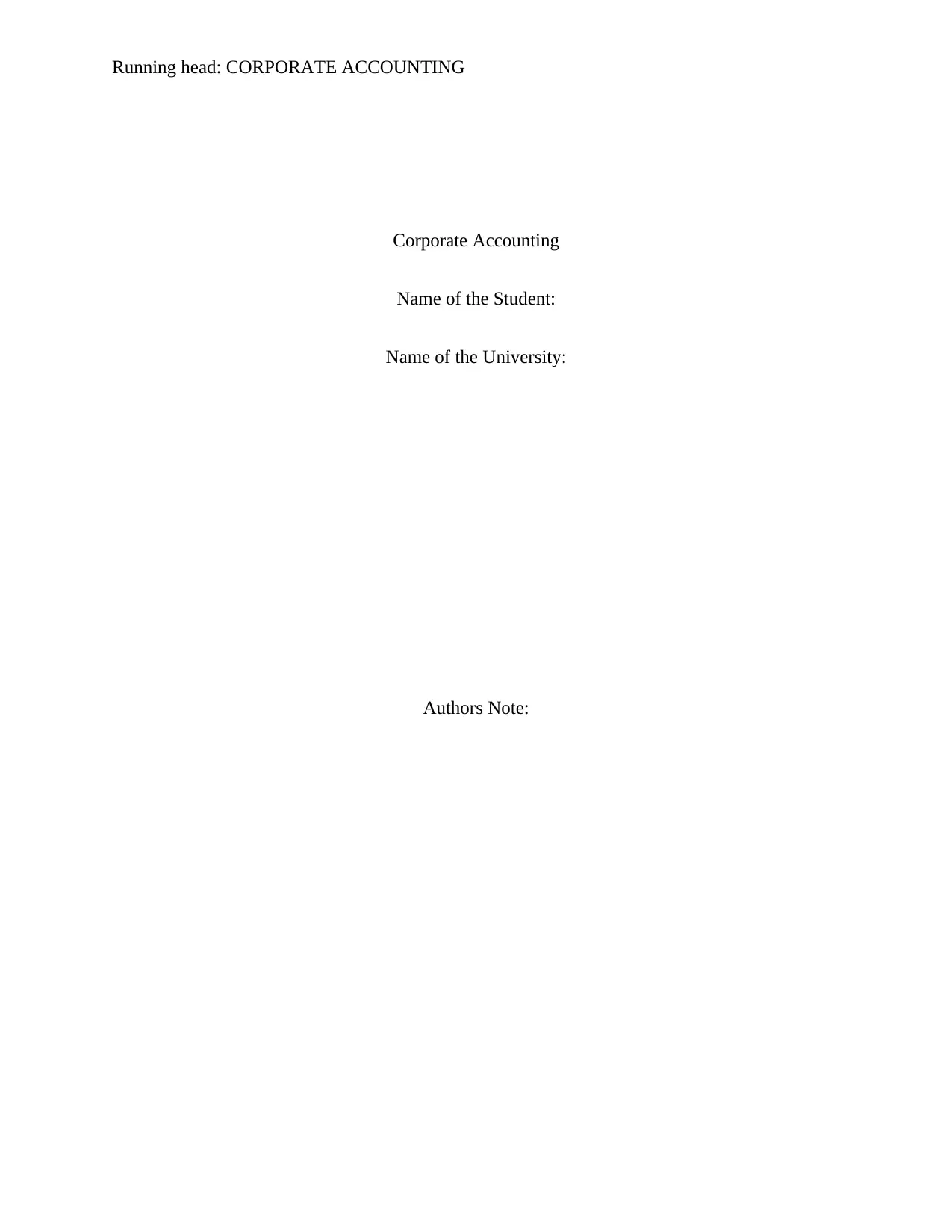
Running head: CORPORATE ACCOUNTING
Corporate Accounting
Name of the Student:
Name of the University:
Authors Note:
Corporate Accounting
Name of the Student:
Name of the University:
Authors Note:
Secure Best Marks with AI Grader
Need help grading? Try our AI Grader for instant feedback on your assignments.
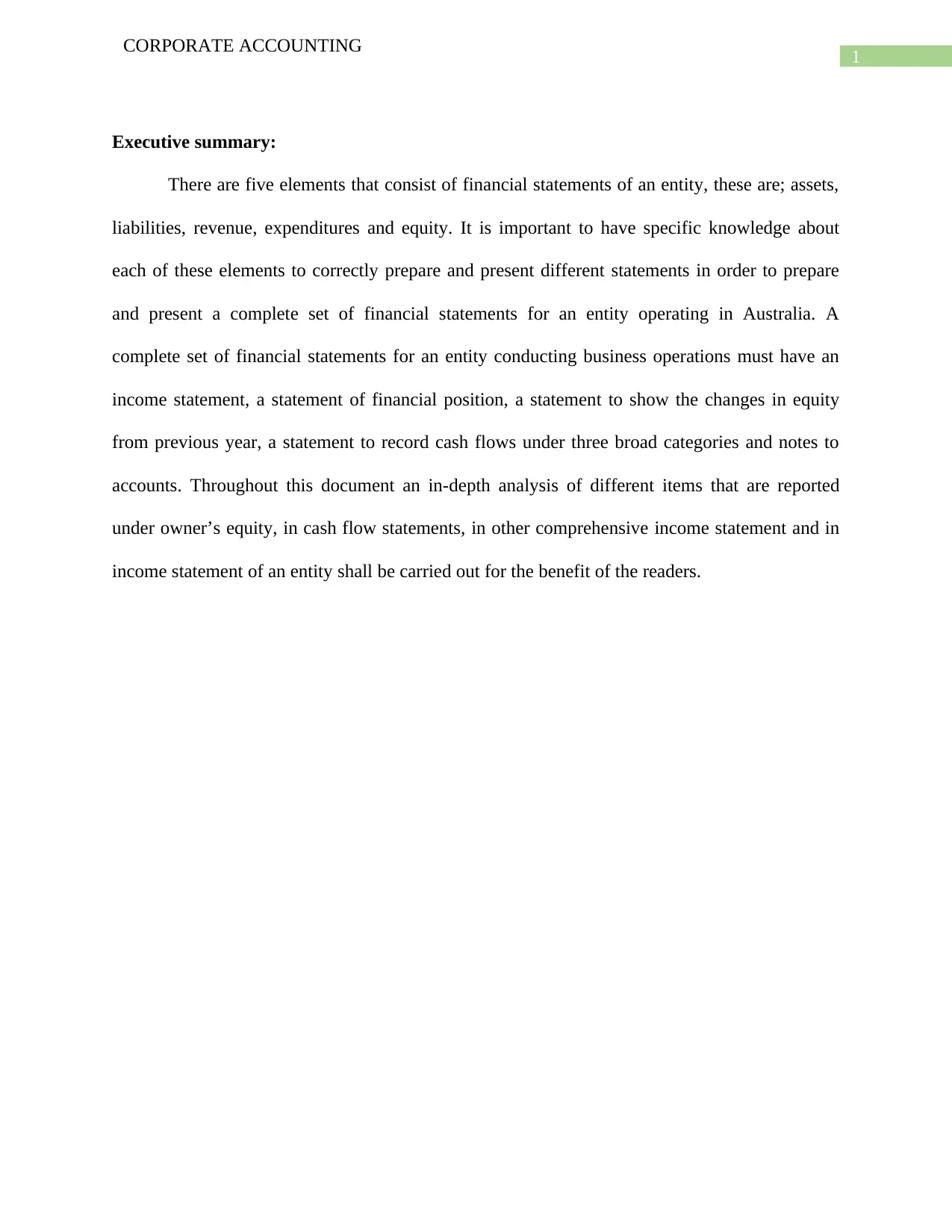
1
CORPORATE ACCOUNTING
Executive summary:
There are five elements that consist of financial statements of an entity, these are; assets,
liabilities, revenue, expenditures and equity. It is important to have specific knowledge about
each of these elements to correctly prepare and present different statements in order to prepare
and present a complete set of financial statements for an entity operating in Australia. A
complete set of financial statements for an entity conducting business operations must have an
income statement, a statement of financial position, a statement to show the changes in equity
from previous year, a statement to record cash flows under three broad categories and notes to
accounts. Throughout this document an in-depth analysis of different items that are reported
under owner’s equity, in cash flow statements, in other comprehensive income statement and in
income statement of an entity shall be carried out for the benefit of the readers.
CORPORATE ACCOUNTING
Executive summary:
There are five elements that consist of financial statements of an entity, these are; assets,
liabilities, revenue, expenditures and equity. It is important to have specific knowledge about
each of these elements to correctly prepare and present different statements in order to prepare
and present a complete set of financial statements for an entity operating in Australia. A
complete set of financial statements for an entity conducting business operations must have an
income statement, a statement of financial position, a statement to show the changes in equity
from previous year, a statement to record cash flows under three broad categories and notes to
accounts. Throughout this document an in-depth analysis of different items that are reported
under owner’s equity, in cash flow statements, in other comprehensive income statement and in
income statement of an entity shall be carried out for the benefit of the readers.
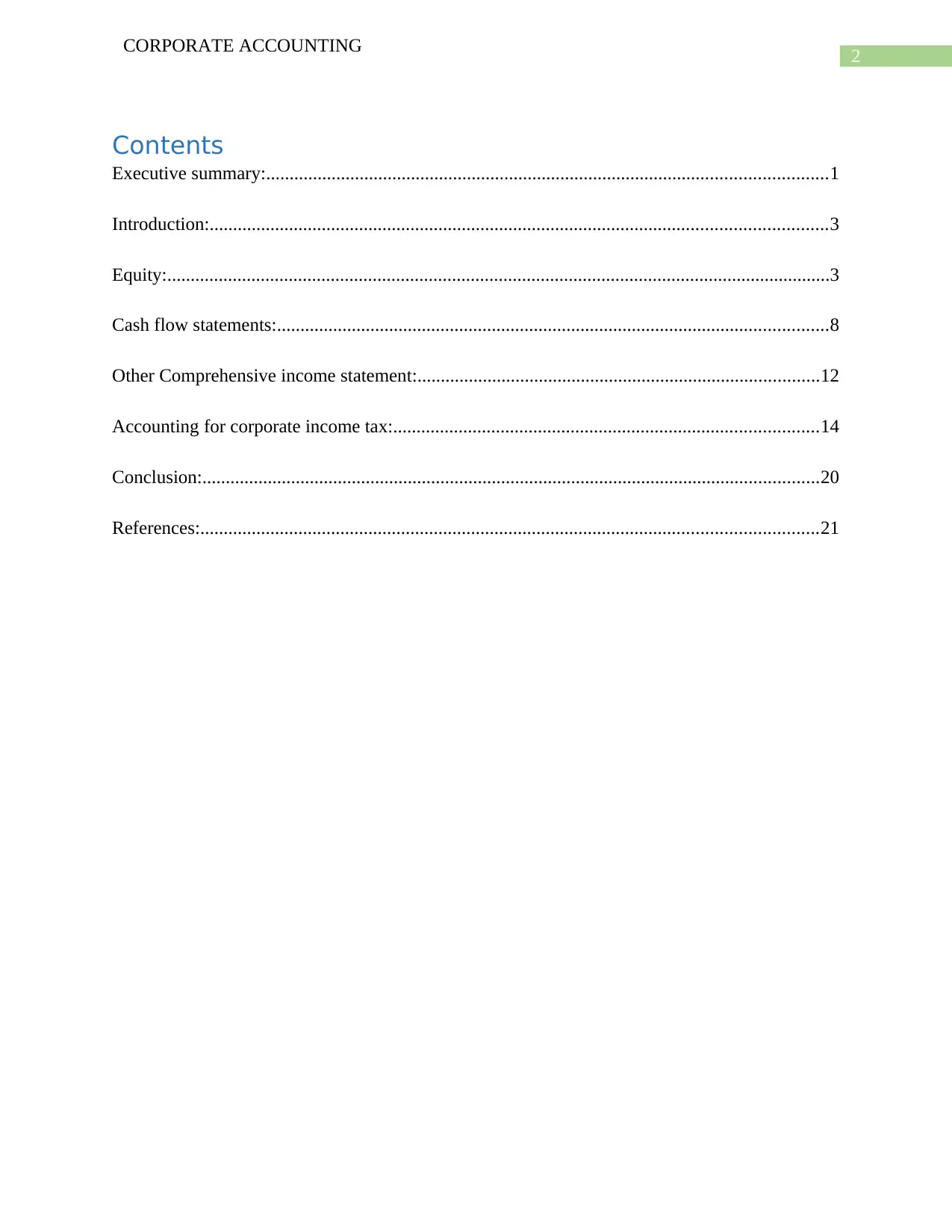
2
CORPORATE ACCOUNTING
Contents
Executive summary:........................................................................................................................1
Introduction:....................................................................................................................................3
Equity:..............................................................................................................................................3
Cash flow statements:......................................................................................................................8
Other Comprehensive income statement:......................................................................................12
Accounting for corporate income tax:...........................................................................................14
Conclusion:....................................................................................................................................20
References:....................................................................................................................................21
CORPORATE ACCOUNTING
Contents
Executive summary:........................................................................................................................1
Introduction:....................................................................................................................................3
Equity:..............................................................................................................................................3
Cash flow statements:......................................................................................................................8
Other Comprehensive income statement:......................................................................................12
Accounting for corporate income tax:...........................................................................................14
Conclusion:....................................................................................................................................20
References:....................................................................................................................................21
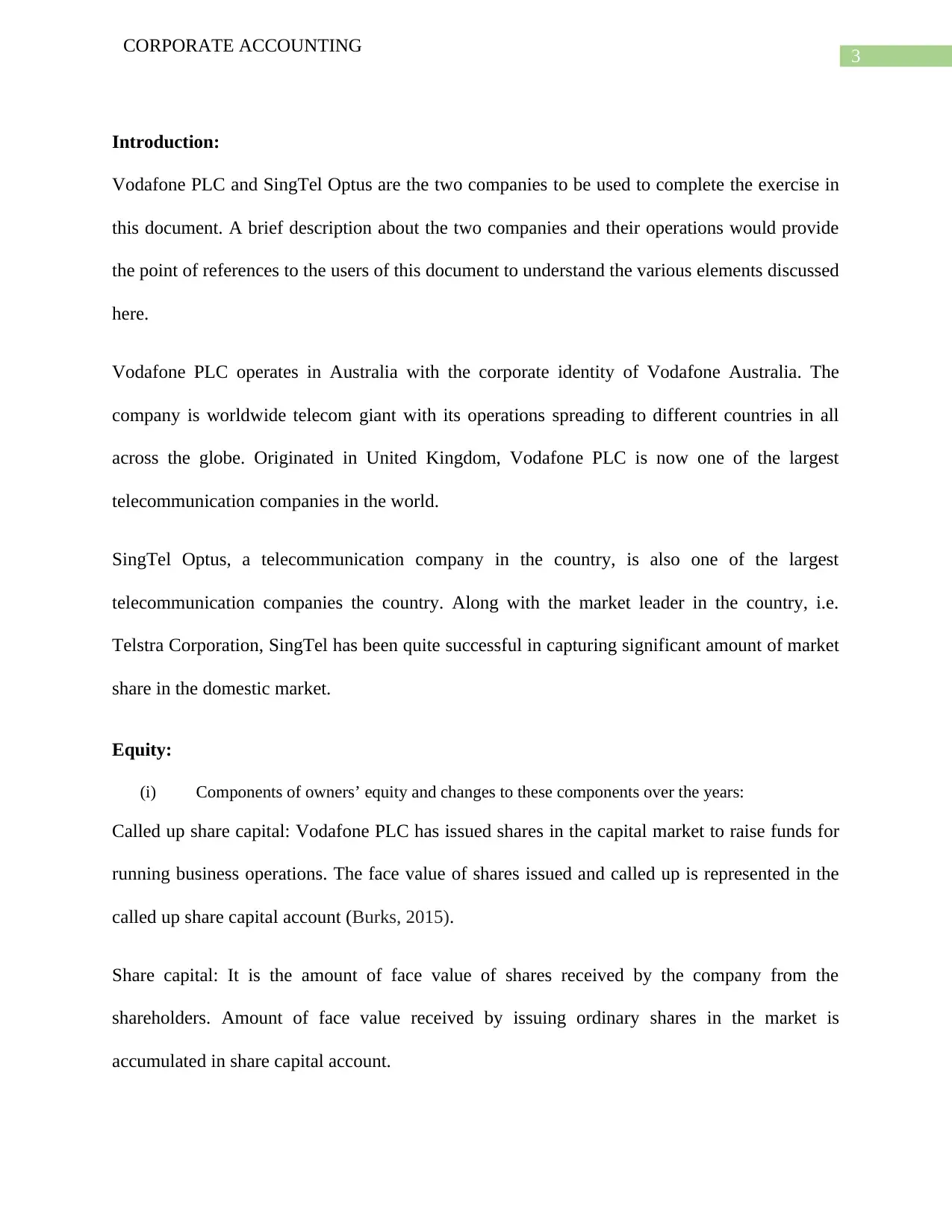
3
CORPORATE ACCOUNTING
Introduction:
Vodafone PLC and SingTel Optus are the two companies to be used to complete the exercise in
this document. A brief description about the two companies and their operations would provide
the point of references to the users of this document to understand the various elements discussed
here.
Vodafone PLC operates in Australia with the corporate identity of Vodafone Australia. The
company is worldwide telecom giant with its operations spreading to different countries in all
across the globe. Originated in United Kingdom, Vodafone PLC is now one of the largest
telecommunication companies in the world.
SingTel Optus, a telecommunication company in the country, is also one of the largest
telecommunication companies the country. Along with the market leader in the country, i.e.
Telstra Corporation, SingTel has been quite successful in capturing significant amount of market
share in the domestic market.
Equity:
(i) Components of owners’ equity and changes to these components over the years:
Called up share capital: Vodafone PLC has issued shares in the capital market to raise funds for
running business operations. The face value of shares issued and called up is represented in the
called up share capital account (Burks, 2015).
Share capital: It is the amount of face value of shares received by the company from the
shareholders. Amount of face value received by issuing ordinary shares in the market is
accumulated in share capital account.
CORPORATE ACCOUNTING
Introduction:
Vodafone PLC and SingTel Optus are the two companies to be used to complete the exercise in
this document. A brief description about the two companies and their operations would provide
the point of references to the users of this document to understand the various elements discussed
here.
Vodafone PLC operates in Australia with the corporate identity of Vodafone Australia. The
company is worldwide telecom giant with its operations spreading to different countries in all
across the globe. Originated in United Kingdom, Vodafone PLC is now one of the largest
telecommunication companies in the world.
SingTel Optus, a telecommunication company in the country, is also one of the largest
telecommunication companies the country. Along with the market leader in the country, i.e.
Telstra Corporation, SingTel has been quite successful in capturing significant amount of market
share in the domestic market.
Equity:
(i) Components of owners’ equity and changes to these components over the years:
Called up share capital: Vodafone PLC has issued shares in the capital market to raise funds for
running business operations. The face value of shares issued and called up is represented in the
called up share capital account (Burks, 2015).
Share capital: It is the amount of face value of shares received by the company from the
shareholders. Amount of face value received by issuing ordinary shares in the market is
accumulated in share capital account.
Secure Best Marks with AI Grader
Need help grading? Try our AI Grader for instant feedback on your assignments.
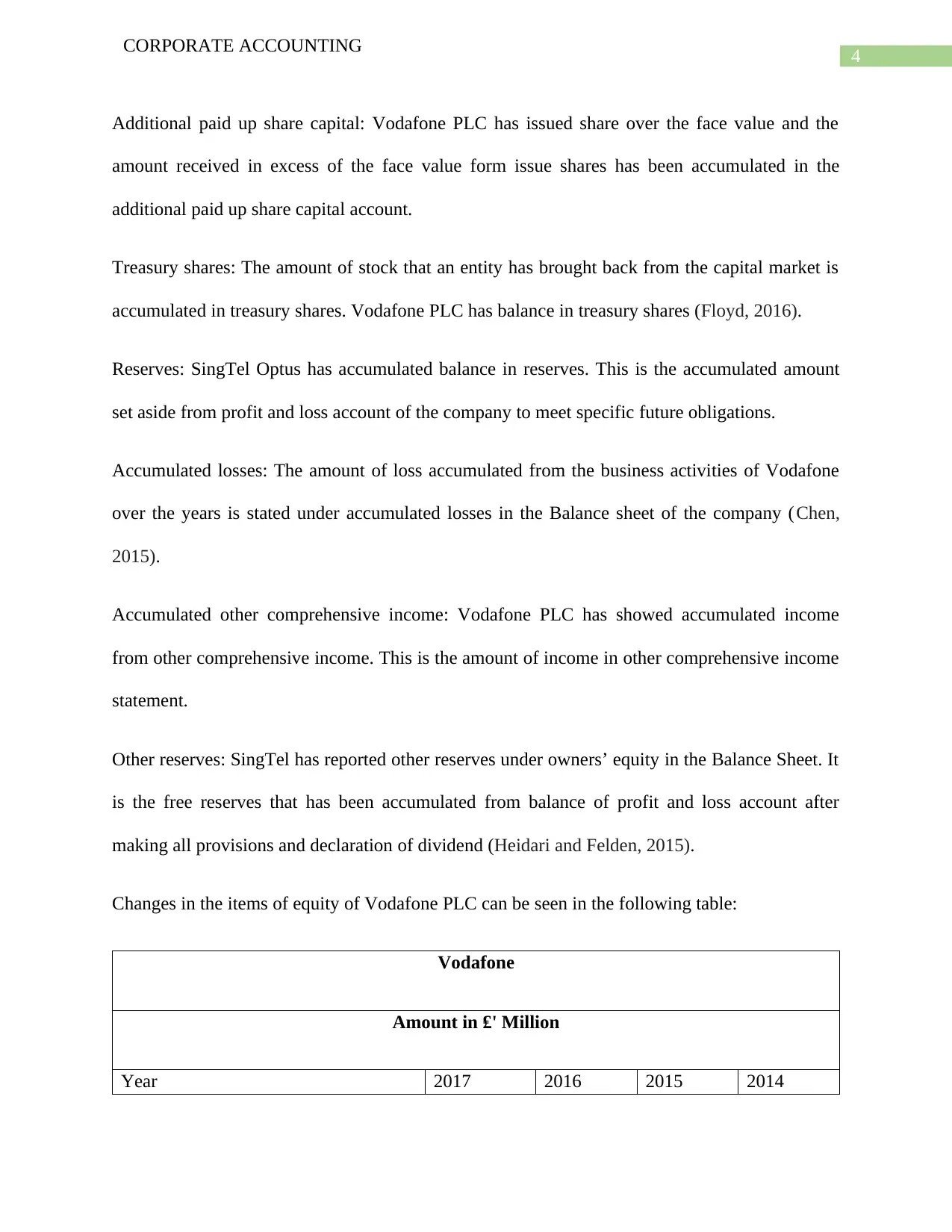
4
CORPORATE ACCOUNTING
Additional paid up share capital: Vodafone PLC has issued share over the face value and the
amount received in excess of the face value form issue shares has been accumulated in the
additional paid up share capital account.
Treasury shares: The amount of stock that an entity has brought back from the capital market is
accumulated in treasury shares. Vodafone PLC has balance in treasury shares (Floyd, 2016).
Reserves: SingTel Optus has accumulated balance in reserves. This is the accumulated amount
set aside from profit and loss account of the company to meet specific future obligations.
Accumulated losses: The amount of loss accumulated from the business activities of Vodafone
over the years is stated under accumulated losses in the Balance sheet of the company (Chen,
2015).
Accumulated other comprehensive income: Vodafone PLC has showed accumulated income
from other comprehensive income. This is the amount of income in other comprehensive income
statement.
Other reserves: SingTel has reported other reserves under owners’ equity in the Balance Sheet. It
is the free reserves that has been accumulated from balance of profit and loss account after
making all provisions and declaration of dividend (Heidari and Felden, 2015).
Changes in the items of equity of Vodafone PLC can be seen in the following table:
Vodafone
Amount in ₤' Million
Year 2017 2016 2015 2014
CORPORATE ACCOUNTING
Additional paid up share capital: Vodafone PLC has issued share over the face value and the
amount received in excess of the face value form issue shares has been accumulated in the
additional paid up share capital account.
Treasury shares: The amount of stock that an entity has brought back from the capital market is
accumulated in treasury shares. Vodafone PLC has balance in treasury shares (Floyd, 2016).
Reserves: SingTel Optus has accumulated balance in reserves. This is the accumulated amount
set aside from profit and loss account of the company to meet specific future obligations.
Accumulated losses: The amount of loss accumulated from the business activities of Vodafone
over the years is stated under accumulated losses in the Balance sheet of the company (Chen,
2015).
Accumulated other comprehensive income: Vodafone PLC has showed accumulated income
from other comprehensive income. This is the amount of income in other comprehensive income
statement.
Other reserves: SingTel has reported other reserves under owners’ equity in the Balance Sheet. It
is the free reserves that has been accumulated from balance of profit and loss account after
making all provisions and declaration of dividend (Heidari and Felden, 2015).
Changes in the items of equity of Vodafone PLC can be seen in the following table:
Vodafone
Amount in ₤' Million
Year 2017 2016 2015 2014
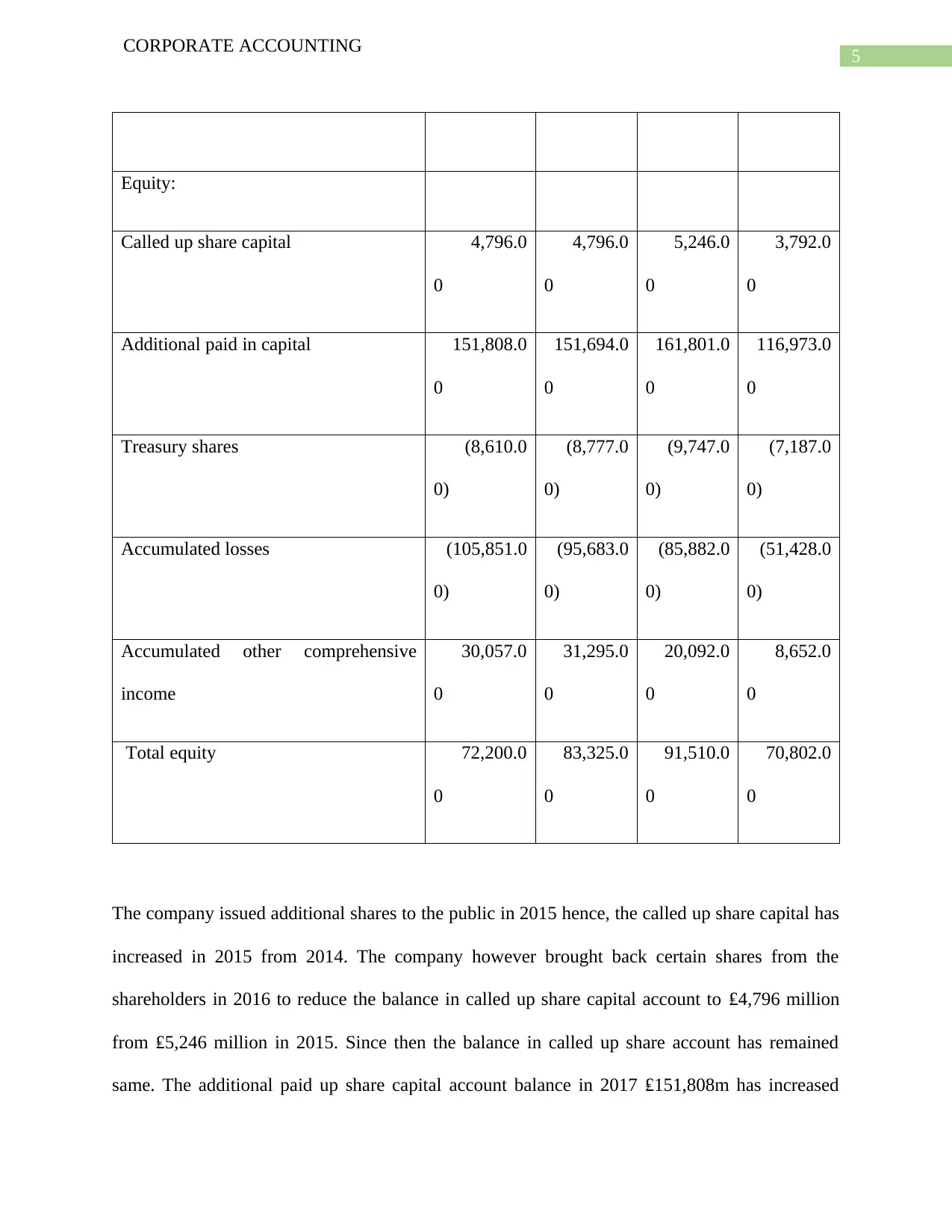
5
CORPORATE ACCOUNTING
Equity:
Called up share capital 4,796.0
0
4,796.0
0
5,246.0
0
3,792.0
0
Additional paid in capital 151,808.0
0
151,694.0
0
161,801.0
0
116,973.0
0
Treasury shares (8,610.0
0)
(8,777.0
0)
(9,747.0
0)
(7,187.0
0)
Accumulated losses (105,851.0
0)
(95,683.0
0)
(85,882.0
0)
(51,428.0
0)
Accumulated other comprehensive
income
30,057.0
0
31,295.0
0
20,092.0
0
8,652.0
0
Total equity 72,200.0
0
83,325.0
0
91,510.0
0
70,802.0
0
The company issued additional shares to the public in 2015 hence, the called up share capital has
increased in 2015 from 2014. The company however brought back certain shares from the
shareholders in 2016 to reduce the balance in called up share capital account to ₤4,796 million
from ₤5,246 million in 2015. Since then the balance in called up share account has remained
same. The additional paid up share capital account balance in 2017 ₤151,808m has increased
CORPORATE ACCOUNTING
Equity:
Called up share capital 4,796.0
0
4,796.0
0
5,246.0
0
3,792.0
0
Additional paid in capital 151,808.0
0
151,694.0
0
161,801.0
0
116,973.0
0
Treasury shares (8,610.0
0)
(8,777.0
0)
(9,747.0
0)
(7,187.0
0)
Accumulated losses (105,851.0
0)
(95,683.0
0)
(85,882.0
0)
(51,428.0
0)
Accumulated other comprehensive
income
30,057.0
0
31,295.0
0
20,092.0
0
8,652.0
0
Total equity 72,200.0
0
83,325.0
0
91,510.0
0
70,802.0
0
The company issued additional shares to the public in 2015 hence, the called up share capital has
increased in 2015 from 2014. The company however brought back certain shares from the
shareholders in 2016 to reduce the balance in called up share capital account to ₤4,796 million
from ₤5,246 million in 2015. Since then the balance in called up share account has remained
same. The additional paid up share capital account balance in 2017 ₤151,808m has increased
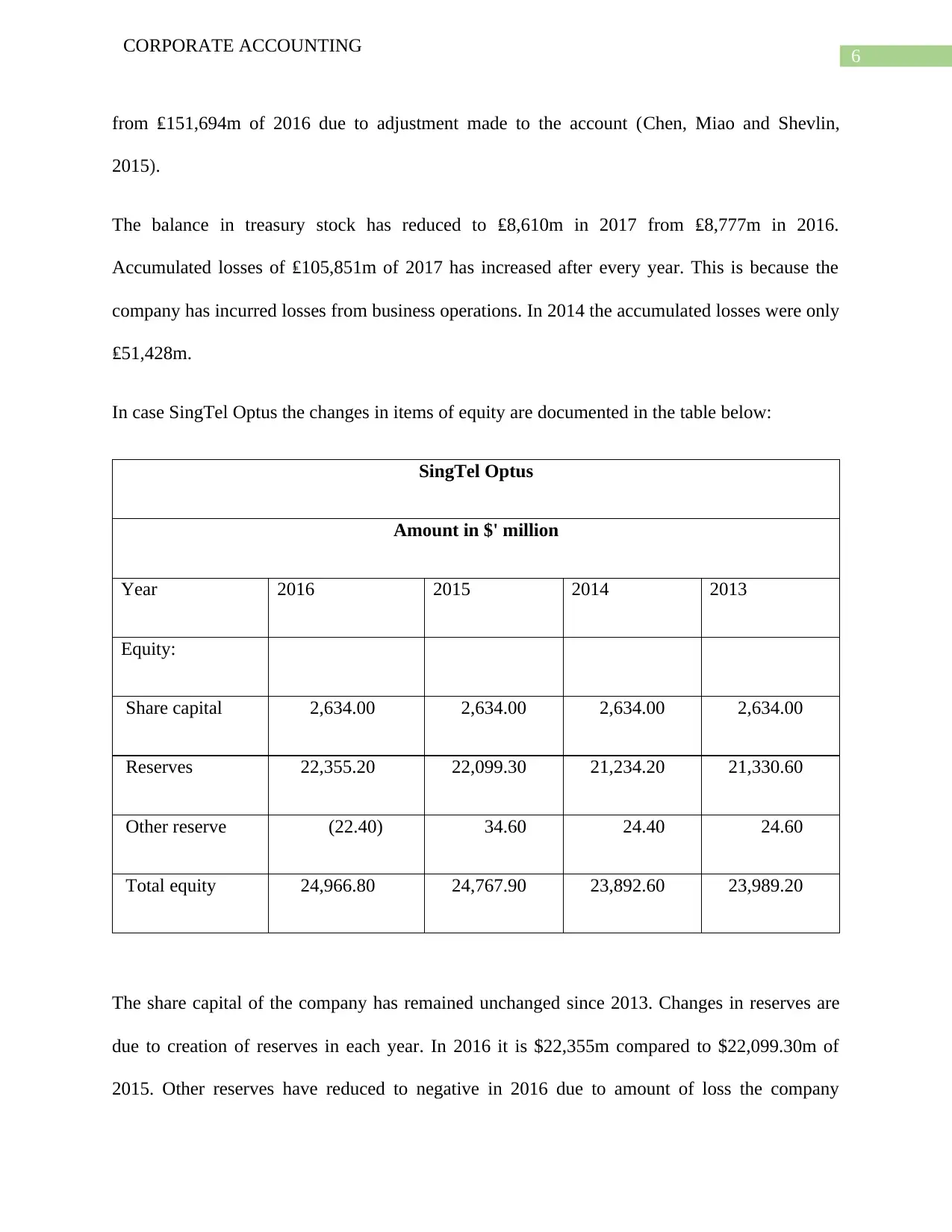
6
CORPORATE ACCOUNTING
from ₤151,694m of 2016 due to adjustment made to the account (Chen, Miao and Shevlin,
2015).
The balance in treasury stock has reduced to ₤8,610m in 2017 from ₤8,777m in 2016.
Accumulated losses of ₤105,851m of 2017 has increased after every year. This is because the
company has incurred losses from business operations. In 2014 the accumulated losses were only
₤51,428m.
In case SingTel Optus the changes in items of equity are documented in the table below:
SingTel Optus
Amount in $' million
Year 2016 2015 2014 2013
Equity:
Share capital 2,634.00 2,634.00 2,634.00 2,634.00
Reserves 22,355.20 22,099.30 21,234.20 21,330.60
Other reserve (22.40) 34.60 24.40 24.60
Total equity 24,966.80 24,767.90 23,892.60 23,989.20
The share capital of the company has remained unchanged since 2013. Changes in reserves are
due to creation of reserves in each year. In 2016 it is $22,355m compared to $22,099.30m of
2015. Other reserves have reduced to negative in 2016 due to amount of loss the company
CORPORATE ACCOUNTING
from ₤151,694m of 2016 due to adjustment made to the account (Chen, Miao and Shevlin,
2015).
The balance in treasury stock has reduced to ₤8,610m in 2017 from ₤8,777m in 2016.
Accumulated losses of ₤105,851m of 2017 has increased after every year. This is because the
company has incurred losses from business operations. In 2014 the accumulated losses were only
₤51,428m.
In case SingTel Optus the changes in items of equity are documented in the table below:
SingTel Optus
Amount in $' million
Year 2016 2015 2014 2013
Equity:
Share capital 2,634.00 2,634.00 2,634.00 2,634.00
Reserves 22,355.20 22,099.30 21,234.20 21,330.60
Other reserve (22.40) 34.60 24.40 24.60
Total equity 24,966.80 24,767.90 23,892.60 23,989.20
The share capital of the company has remained unchanged since 2013. Changes in reserves are
due to creation of reserves in each year. In 2016 it is $22,355m compared to $22,099.30m of
2015. Other reserves have reduced to negative in 2016 due to amount of loss the company
Paraphrase This Document
Need a fresh take? Get an instant paraphrase of this document with our AI Paraphraser
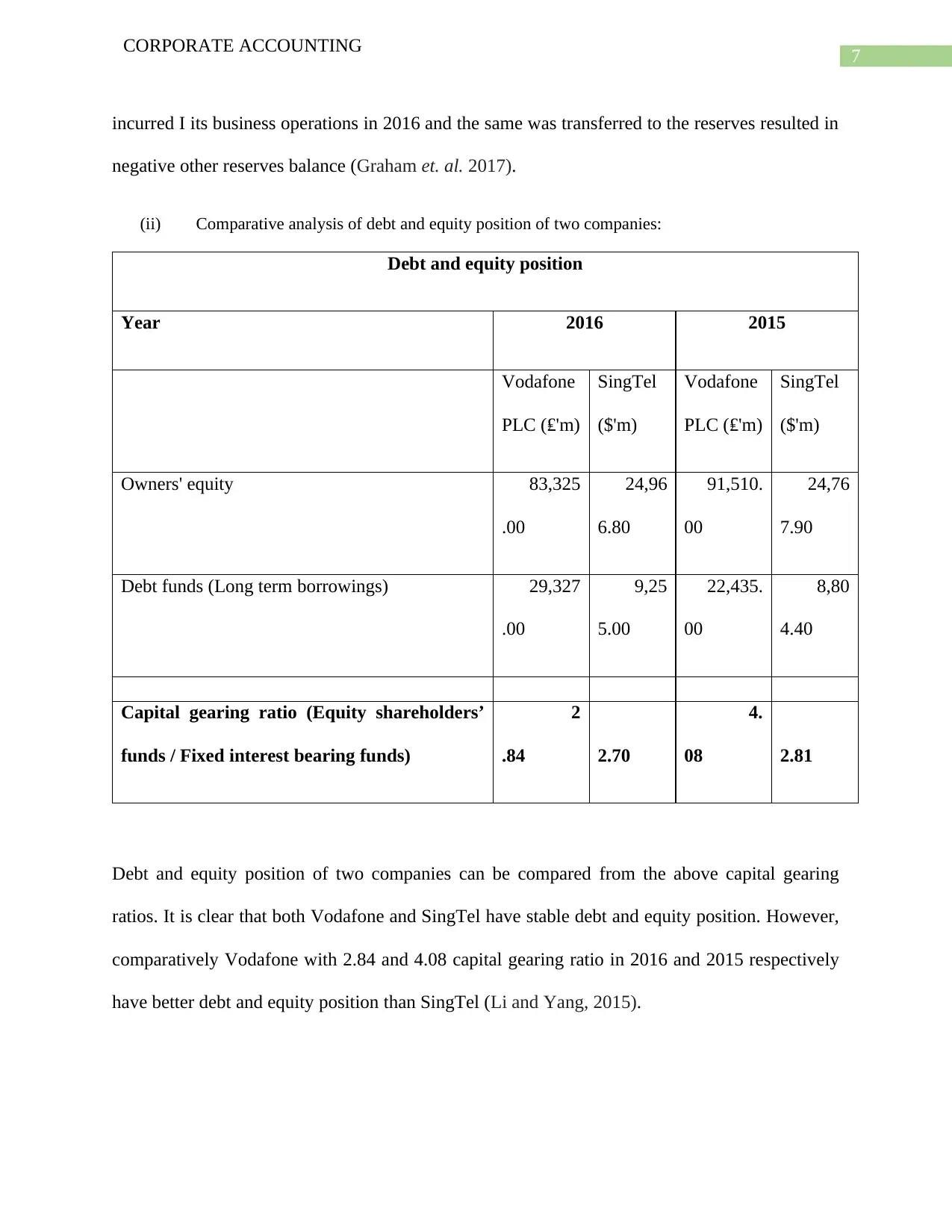
7
CORPORATE ACCOUNTING
incurred I its business operations in 2016 and the same was transferred to the reserves resulted in
negative other reserves balance (Graham et. al. 2017).
(ii) Comparative analysis of debt and equity position of two companies:
Debt and equity position
Year 2016 2015
Vodafone
PLC (₤'m)
SingTel
($'m)
Vodafone
PLC (₤'m)
SingTel
($'m)
Owners' equity 83,325
.00
24,96
6.80
91,510.
00
24,76
7.90
Debt funds (Long term borrowings) 29,327
.00
9,25
5.00
22,435.
00
8,80
4.40
Capital gearing ratio (Equity shareholders’
funds / Fixed interest bearing funds)
2
.84 2.70
4.
08 2.81
Debt and equity position of two companies can be compared from the above capital gearing
ratios. It is clear that both Vodafone and SingTel have stable debt and equity position. However,
comparatively Vodafone with 2.84 and 4.08 capital gearing ratio in 2016 and 2015 respectively
have better debt and equity position than SingTel (Li and Yang, 2015).
CORPORATE ACCOUNTING
incurred I its business operations in 2016 and the same was transferred to the reserves resulted in
negative other reserves balance (Graham et. al. 2017).
(ii) Comparative analysis of debt and equity position of two companies:
Debt and equity position
Year 2016 2015
Vodafone
PLC (₤'m)
SingTel
($'m)
Vodafone
PLC (₤'m)
SingTel
($'m)
Owners' equity 83,325
.00
24,96
6.80
91,510.
00
24,76
7.90
Debt funds (Long term borrowings) 29,327
.00
9,25
5.00
22,435.
00
8,80
4.40
Capital gearing ratio (Equity shareholders’
funds / Fixed interest bearing funds)
2
.84 2.70
4.
08 2.81
Debt and equity position of two companies can be compared from the above capital gearing
ratios. It is clear that both Vodafone and SingTel have stable debt and equity position. However,
comparatively Vodafone with 2.84 and 4.08 capital gearing ratio in 2016 and 2015 respectively
have better debt and equity position than SingTel (Li and Yang, 2015).
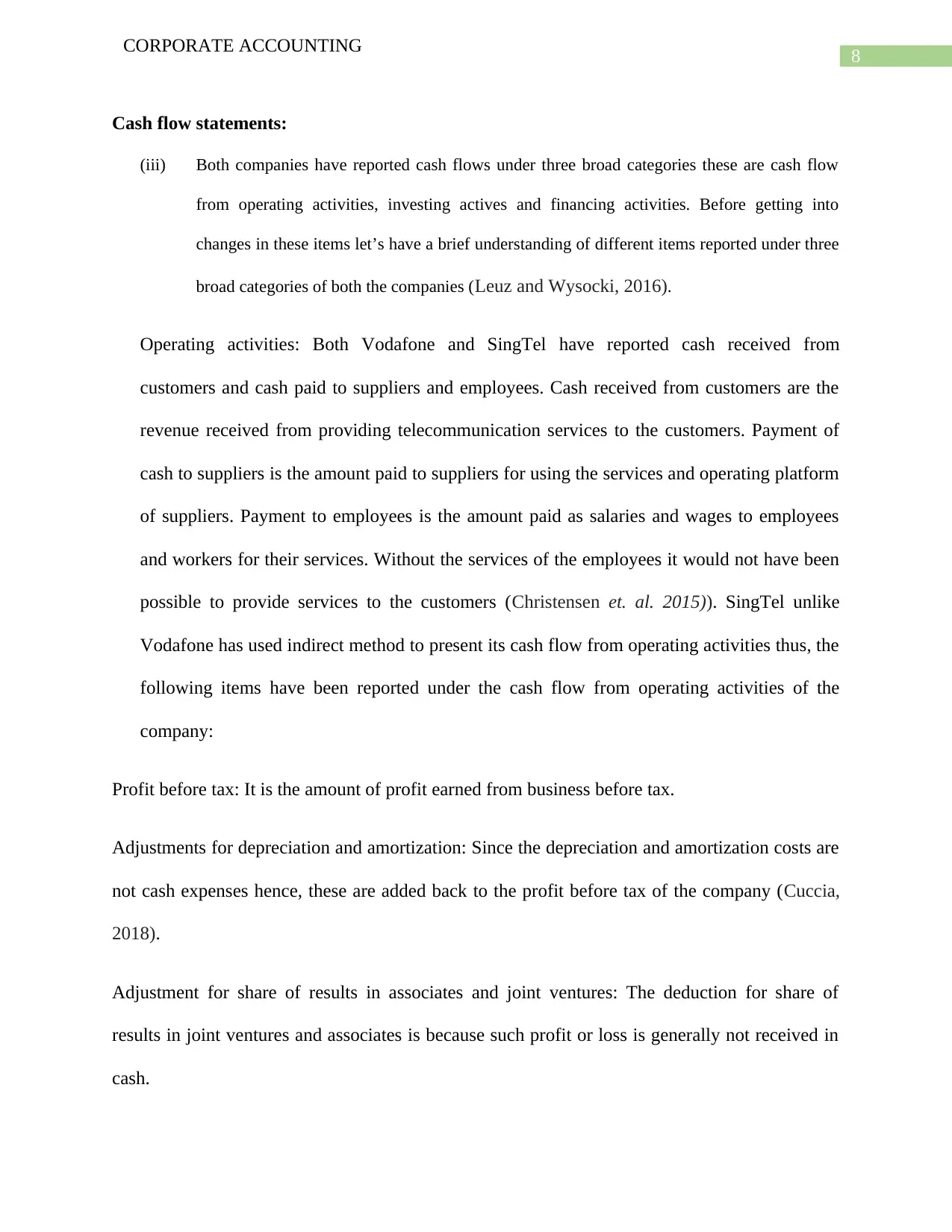
8
CORPORATE ACCOUNTING
Cash flow statements:
(iii) Both companies have reported cash flows under three broad categories these are cash flow
from operating activities, investing actives and financing activities. Before getting into
changes in these items let’s have a brief understanding of different items reported under three
broad categories of both the companies (Leuz and Wysocki, 2016).
Operating activities: Both Vodafone and SingTel have reported cash received from
customers and cash paid to suppliers and employees. Cash received from customers are the
revenue received from providing telecommunication services to the customers. Payment of
cash to suppliers is the amount paid to suppliers for using the services and operating platform
of suppliers. Payment to employees is the amount paid as salaries and wages to employees
and workers for their services. Without the services of the employees it would not have been
possible to provide services to the customers (Christensen et. al. 2015)). SingTel unlike
Vodafone has used indirect method to present its cash flow from operating activities thus, the
following items have been reported under the cash flow from operating activities of the
company:
Profit before tax: It is the amount of profit earned from business before tax.
Adjustments for depreciation and amortization: Since the depreciation and amortization costs are
not cash expenses hence, these are added back to the profit before tax of the company (Cuccia,
2018).
Adjustment for share of results in associates and joint ventures: The deduction for share of
results in joint ventures and associates is because such profit or loss is generally not received in
cash.
CORPORATE ACCOUNTING
Cash flow statements:
(iii) Both companies have reported cash flows under three broad categories these are cash flow
from operating activities, investing actives and financing activities. Before getting into
changes in these items let’s have a brief understanding of different items reported under three
broad categories of both the companies (Leuz and Wysocki, 2016).
Operating activities: Both Vodafone and SingTel have reported cash received from
customers and cash paid to suppliers and employees. Cash received from customers are the
revenue received from providing telecommunication services to the customers. Payment of
cash to suppliers is the amount paid to suppliers for using the services and operating platform
of suppliers. Payment to employees is the amount paid as salaries and wages to employees
and workers for their services. Without the services of the employees it would not have been
possible to provide services to the customers (Christensen et. al. 2015)). SingTel unlike
Vodafone has used indirect method to present its cash flow from operating activities thus, the
following items have been reported under the cash flow from operating activities of the
company:
Profit before tax: It is the amount of profit earned from business before tax.
Adjustments for depreciation and amortization: Since the depreciation and amortization costs are
not cash expenses hence, these are added back to the profit before tax of the company (Cuccia,
2018).
Adjustment for share of results in associates and joint ventures: The deduction for share of
results in joint ventures and associates is because such profit or loss is generally not received in
cash.
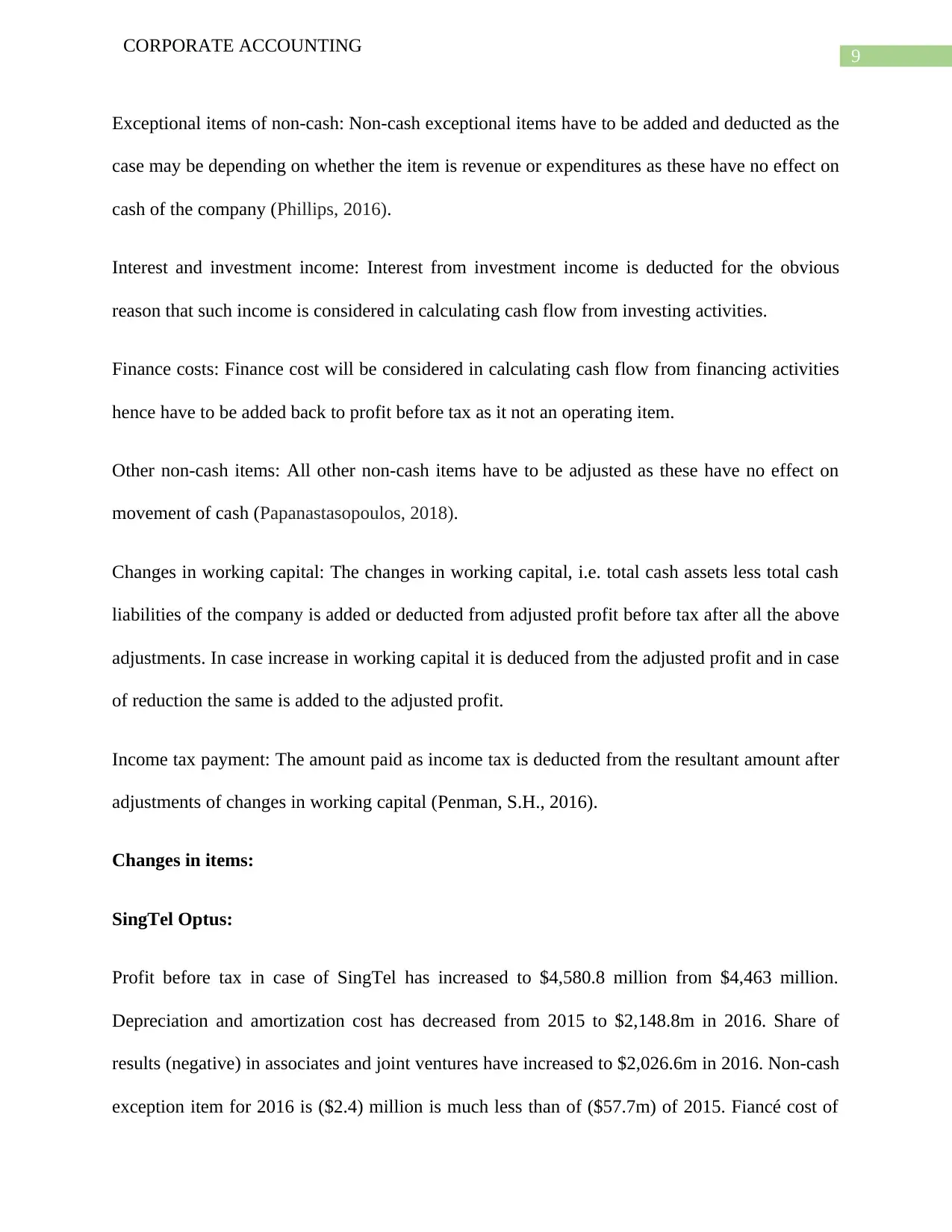
9
CORPORATE ACCOUNTING
Exceptional items of non-cash: Non-cash exceptional items have to be added and deducted as the
case may be depending on whether the item is revenue or expenditures as these have no effect on
cash of the company (Phillips, 2016).
Interest and investment income: Interest from investment income is deducted for the obvious
reason that such income is considered in calculating cash flow from investing activities.
Finance costs: Finance cost will be considered in calculating cash flow from financing activities
hence have to be added back to profit before tax as it not an operating item.
Other non-cash items: All other non-cash items have to be adjusted as these have no effect on
movement of cash (Papanastasopoulos, 2018).
Changes in working capital: The changes in working capital, i.e. total cash assets less total cash
liabilities of the company is added or deducted from adjusted profit before tax after all the above
adjustments. In case increase in working capital it is deduced from the adjusted profit and in case
of reduction the same is added to the adjusted profit.
Income tax payment: The amount paid as income tax is deducted from the resultant amount after
adjustments of changes in working capital (Penman, S.H., 2016).
Changes in items:
SingTel Optus:
Profit before tax in case of SingTel has increased to $4,580.8 million from $4,463 million.
Depreciation and amortization cost has decreased from 2015 to $2,148.8m in 2016. Share of
results (negative) in associates and joint ventures have increased to $2,026.6m in 2016. Non-cash
exception item for 2016 is ($2.4) million is much less than of ($57.7m) of 2015. Fiancé cost of
CORPORATE ACCOUNTING
Exceptional items of non-cash: Non-cash exceptional items have to be added and deducted as the
case may be depending on whether the item is revenue or expenditures as these have no effect on
cash of the company (Phillips, 2016).
Interest and investment income: Interest from investment income is deducted for the obvious
reason that such income is considered in calculating cash flow from investing activities.
Finance costs: Finance cost will be considered in calculating cash flow from financing activities
hence have to be added back to profit before tax as it not an operating item.
Other non-cash items: All other non-cash items have to be adjusted as these have no effect on
movement of cash (Papanastasopoulos, 2018).
Changes in working capital: The changes in working capital, i.e. total cash assets less total cash
liabilities of the company is added or deducted from adjusted profit before tax after all the above
adjustments. In case increase in working capital it is deduced from the adjusted profit and in case
of reduction the same is added to the adjusted profit.
Income tax payment: The amount paid as income tax is deducted from the resultant amount after
adjustments of changes in working capital (Penman, S.H., 2016).
Changes in items:
SingTel Optus:
Profit before tax in case of SingTel has increased to $4,580.8 million from $4,463 million.
Depreciation and amortization cost has decreased from 2015 to $2,148.8m in 2016. Share of
results (negative) in associates and joint ventures have increased to $2,026.6m in 2016. Non-cash
exception item for 2016 is ($2.4) million is much less than of ($57.7m) of 2015. Fiancé cost of
Secure Best Marks with AI Grader
Need help grading? Try our AI Grader for instant feedback on your assignments.
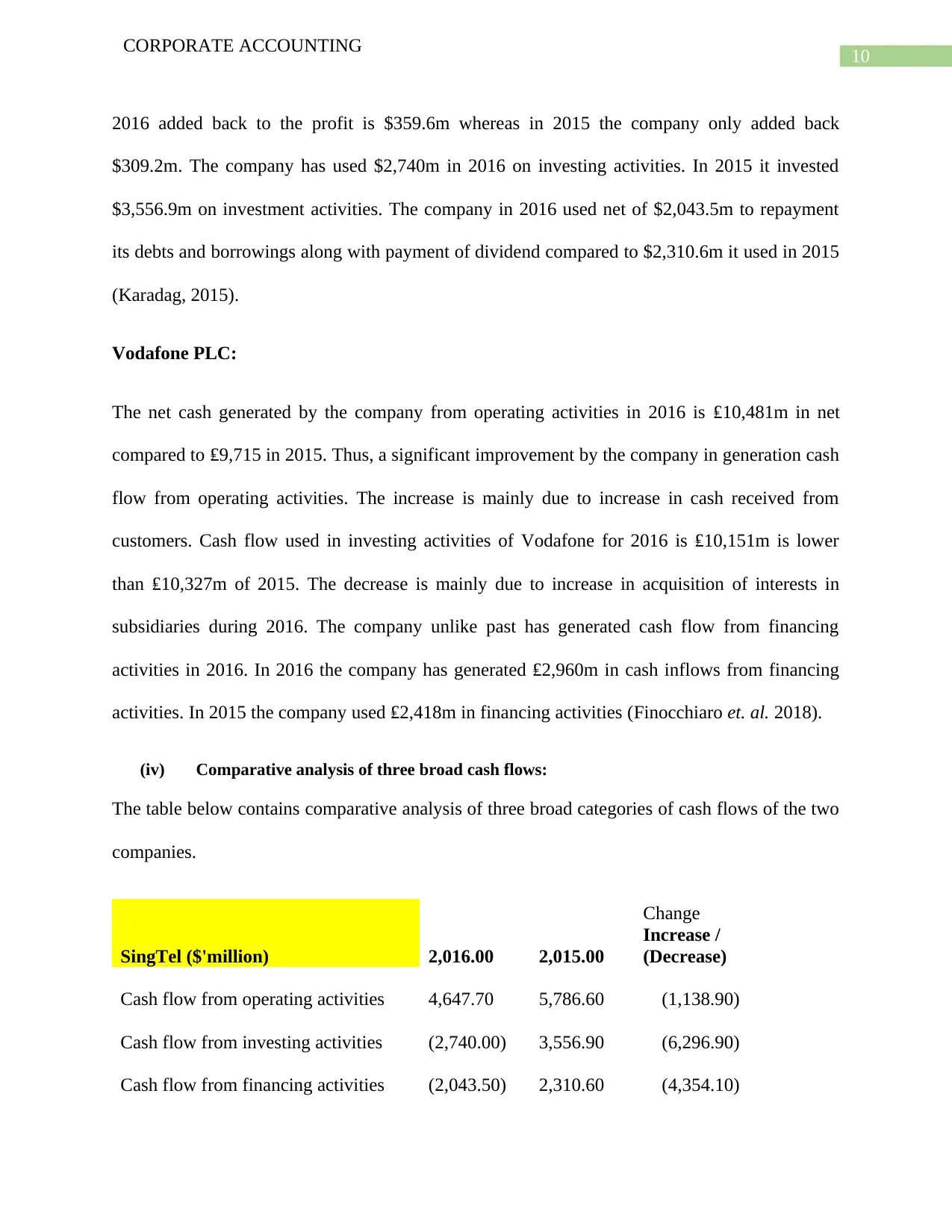
10
CORPORATE ACCOUNTING
2016 added back to the profit is $359.6m whereas in 2015 the company only added back
$309.2m. The company has used $2,740m in 2016 on investing activities. In 2015 it invested
$3,556.9m on investment activities. The company in 2016 used net of $2,043.5m to repayment
its debts and borrowings along with payment of dividend compared to $2,310.6m it used in 2015
(Karadag, 2015).
Vodafone PLC:
The net cash generated by the company from operating activities in 2016 is ₤10,481m in net
compared to ₤9,715 in 2015. Thus, a significant improvement by the company in generation cash
flow from operating activities. The increase is mainly due to increase in cash received from
customers. Cash flow used in investing activities of Vodafone for 2016 is ₤10,151m is lower
than ₤10,327m of 2015. The decrease is mainly due to increase in acquisition of interests in
subsidiaries during 2016. The company unlike past has generated cash flow from financing
activities in 2016. In 2016 the company has generated ₤2,960m in cash inflows from financing
activities. In 2015 the company used ₤2,418m in financing activities (Finocchiaro et. al. 2018).
(iv) Comparative analysis of three broad cash flows:
The table below contains comparative analysis of three broad categories of cash flows of the two
companies.
Change
SingTel ($'million) 2,016.00 2,015.00
Increase /
(Decrease)
Cash flow from operating activities 4,647.70 5,786.60 (1,138.90)
Cash flow from investing activities (2,740.00) 3,556.90 (6,296.90)
Cash flow from financing activities (2,043.50) 2,310.60 (4,354.10)
CORPORATE ACCOUNTING
2016 added back to the profit is $359.6m whereas in 2015 the company only added back
$309.2m. The company has used $2,740m in 2016 on investing activities. In 2015 it invested
$3,556.9m on investment activities. The company in 2016 used net of $2,043.5m to repayment
its debts and borrowings along with payment of dividend compared to $2,310.6m it used in 2015
(Karadag, 2015).
Vodafone PLC:
The net cash generated by the company from operating activities in 2016 is ₤10,481m in net
compared to ₤9,715 in 2015. Thus, a significant improvement by the company in generation cash
flow from operating activities. The increase is mainly due to increase in cash received from
customers. Cash flow used in investing activities of Vodafone for 2016 is ₤10,151m is lower
than ₤10,327m of 2015. The decrease is mainly due to increase in acquisition of interests in
subsidiaries during 2016. The company unlike past has generated cash flow from financing
activities in 2016. In 2016 the company has generated ₤2,960m in cash inflows from financing
activities. In 2015 the company used ₤2,418m in financing activities (Finocchiaro et. al. 2018).
(iv) Comparative analysis of three broad cash flows:
The table below contains comparative analysis of three broad categories of cash flows of the two
companies.
Change
SingTel ($'million) 2,016.00 2,015.00
Increase /
(Decrease)
Cash flow from operating activities 4,647.70 5,786.60 (1,138.90)
Cash flow from investing activities (2,740.00) 3,556.90 (6,296.90)
Cash flow from financing activities (2,043.50) 2,310.60 (4,354.10)
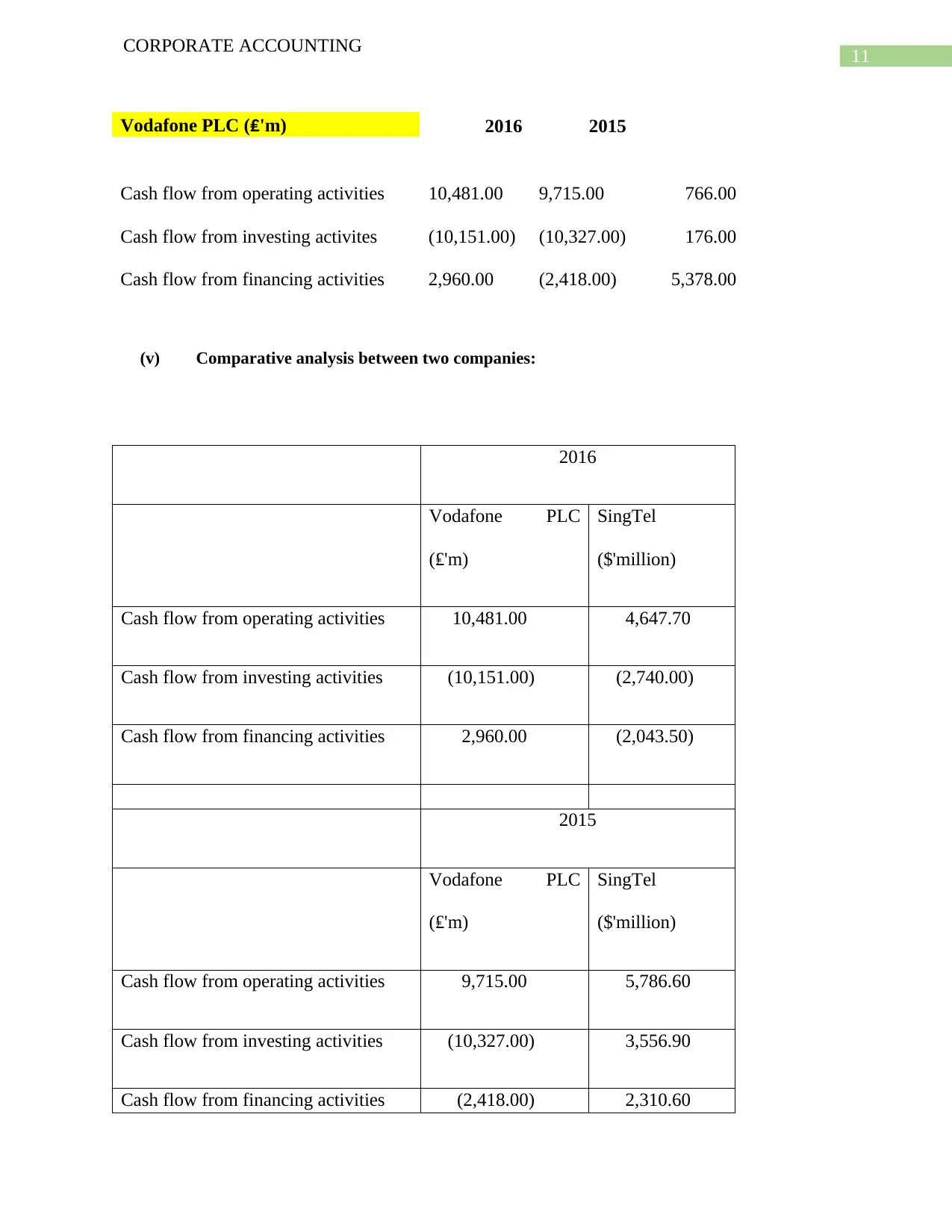
11
CORPORATE ACCOUNTING
Vodafone PLC (₤'m) 2016 2015
Cash flow from operating activities 10,481.00 9,715.00 766.00
Cash flow from investing activites (10,151.00) (10,327.00) 176.00
Cash flow from financing activities 2,960.00 (2,418.00) 5,378.00
(v) Comparative analysis between two companies:
2016
Vodafone PLC
(₤'m)
SingTel
($'million)
Cash flow from operating activities 10,481.00 4,647.70
Cash flow from investing activities (10,151.00) (2,740.00)
Cash flow from financing activities 2,960.00 (2,043.50)
2015
Vodafone PLC
(₤'m)
SingTel
($'million)
Cash flow from operating activities 9,715.00 5,786.60
Cash flow from investing activities (10,327.00) 3,556.90
Cash flow from financing activities (2,418.00) 2,310.60
CORPORATE ACCOUNTING
Vodafone PLC (₤'m) 2016 2015
Cash flow from operating activities 10,481.00 9,715.00 766.00
Cash flow from investing activites (10,151.00) (10,327.00) 176.00
Cash flow from financing activities 2,960.00 (2,418.00) 5,378.00
(v) Comparative analysis between two companies:
2016
Vodafone PLC
(₤'m)
SingTel
($'million)
Cash flow from operating activities 10,481.00 4,647.70
Cash flow from investing activities (10,151.00) (2,740.00)
Cash flow from financing activities 2,960.00 (2,043.50)
2015
Vodafone PLC
(₤'m)
SingTel
($'million)
Cash flow from operating activities 9,715.00 5,786.60
Cash flow from investing activities (10,327.00) 3,556.90
Cash flow from financing activities (2,418.00) 2,310.60
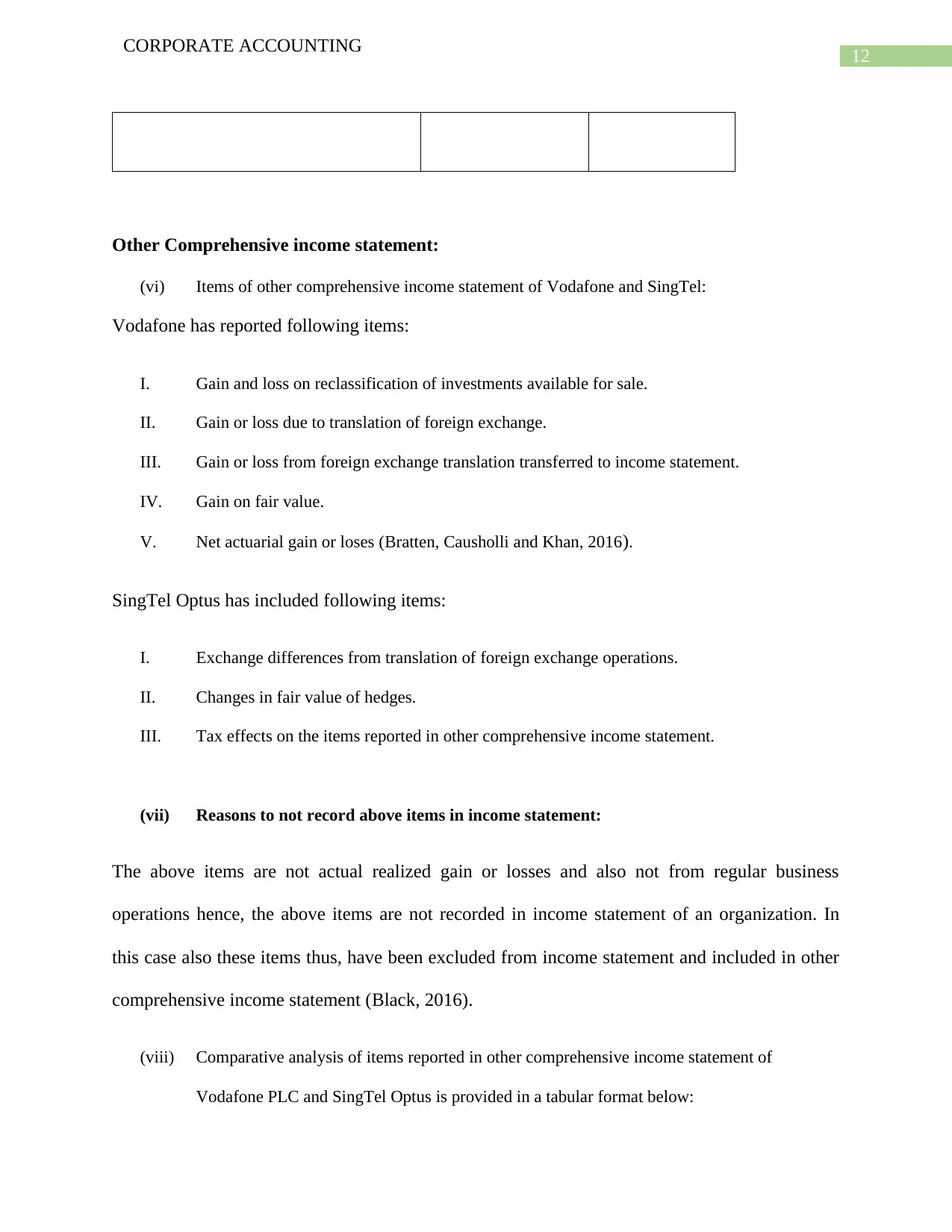
12
CORPORATE ACCOUNTING
Other Comprehensive income statement:
(vi) Items of other comprehensive income statement of Vodafone and SingTel:
Vodafone has reported following items:
I. Gain and loss on reclassification of investments available for sale.
II. Gain or loss due to translation of foreign exchange.
III. Gain or loss from foreign exchange translation transferred to income statement.
IV. Gain on fair value.
V. Net actuarial gain or loses (Bratten, Causholli and Khan, 2016).
SingTel Optus has included following items:
I. Exchange differences from translation of foreign exchange operations.
II. Changes in fair value of hedges.
III. Tax effects on the items reported in other comprehensive income statement.
(vii) Reasons to not record above items in income statement:
The above items are not actual realized gain or losses and also not from regular business
operations hence, the above items are not recorded in income statement of an organization. In
this case also these items thus, have been excluded from income statement and included in other
comprehensive income statement (Black, 2016).
(viii) Comparative analysis of items reported in other comprehensive income statement of
Vodafone PLC and SingTel Optus is provided in a tabular format below:
CORPORATE ACCOUNTING
Other Comprehensive income statement:
(vi) Items of other comprehensive income statement of Vodafone and SingTel:
Vodafone has reported following items:
I. Gain and loss on reclassification of investments available for sale.
II. Gain or loss due to translation of foreign exchange.
III. Gain or loss from foreign exchange translation transferred to income statement.
IV. Gain on fair value.
V. Net actuarial gain or loses (Bratten, Causholli and Khan, 2016).
SingTel Optus has included following items:
I. Exchange differences from translation of foreign exchange operations.
II. Changes in fair value of hedges.
III. Tax effects on the items reported in other comprehensive income statement.
(vii) Reasons to not record above items in income statement:
The above items are not actual realized gain or losses and also not from regular business
operations hence, the above items are not recorded in income statement of an organization. In
this case also these items thus, have been excluded from income statement and included in other
comprehensive income statement (Black, 2016).
(viii) Comparative analysis of items reported in other comprehensive income statement of
Vodafone PLC and SingTel Optus is provided in a tabular format below:
Paraphrase This Document
Need a fresh take? Get an instant paraphrase of this document with our AI Paraphraser
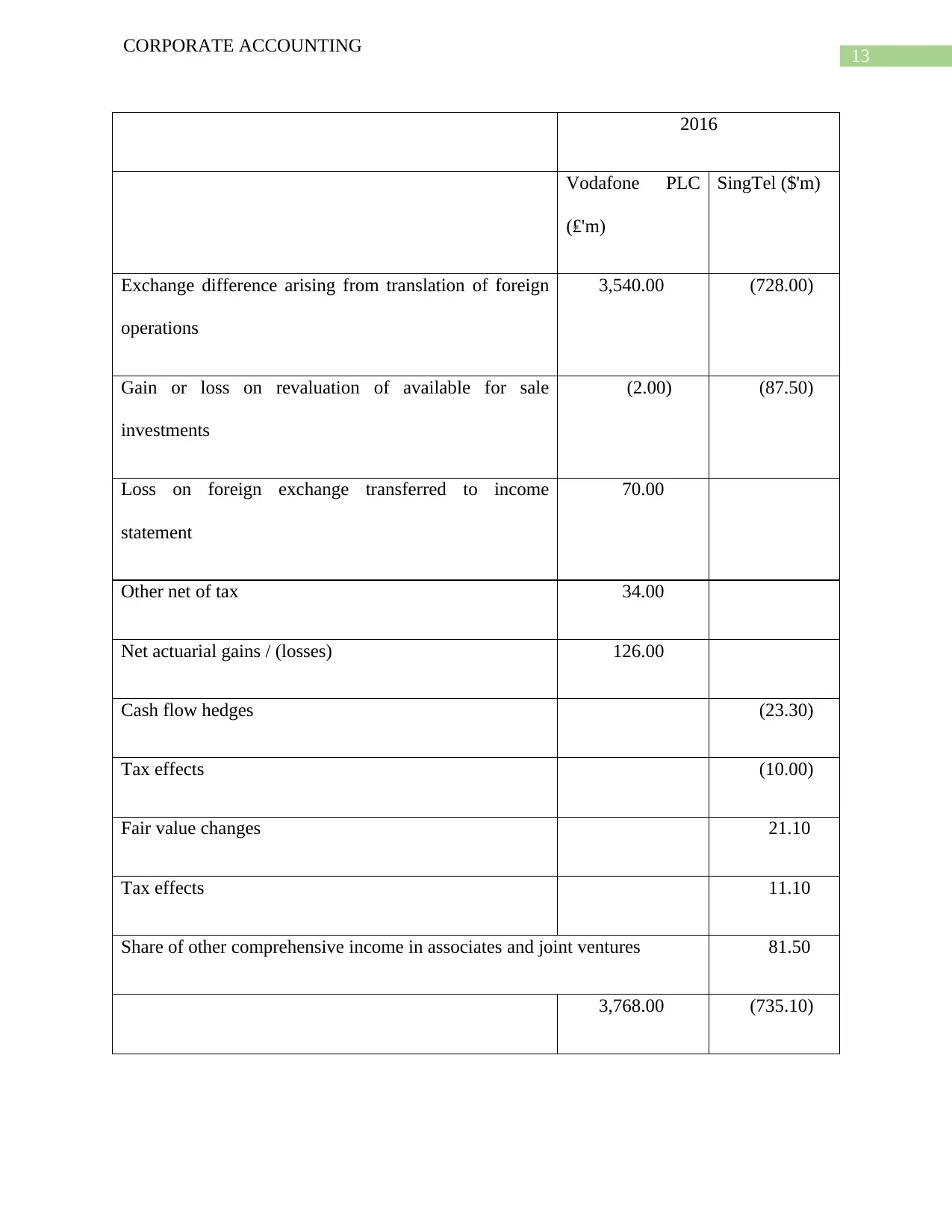
13
CORPORATE ACCOUNTING
2016
Vodafone PLC
(₤'m)
SingTel ($'m)
Exchange difference arising from translation of foreign
operations
3,540.00 (728.00)
Gain or loss on revaluation of available for sale
investments
(2.00) (87.50)
Loss on foreign exchange transferred to income
statement
70.00
Other net of tax 34.00
Net actuarial gains / (losses) 126.00
Cash flow hedges (23.30)
Tax effects (10.00)
Fair value changes 21.10
Tax effects 11.10
Share of other comprehensive income in associates and joint ventures 81.50
3,768.00 (735.10)
CORPORATE ACCOUNTING
2016
Vodafone PLC
(₤'m)
SingTel ($'m)
Exchange difference arising from translation of foreign
operations
3,540.00 (728.00)
Gain or loss on revaluation of available for sale
investments
(2.00) (87.50)
Loss on foreign exchange transferred to income
statement
70.00
Other net of tax 34.00
Net actuarial gains / (losses) 126.00
Cash flow hedges (23.30)
Tax effects (10.00)
Fair value changes 21.10
Tax effects 11.10
Share of other comprehensive income in associates and joint ventures 81.50
3,768.00 (735.10)
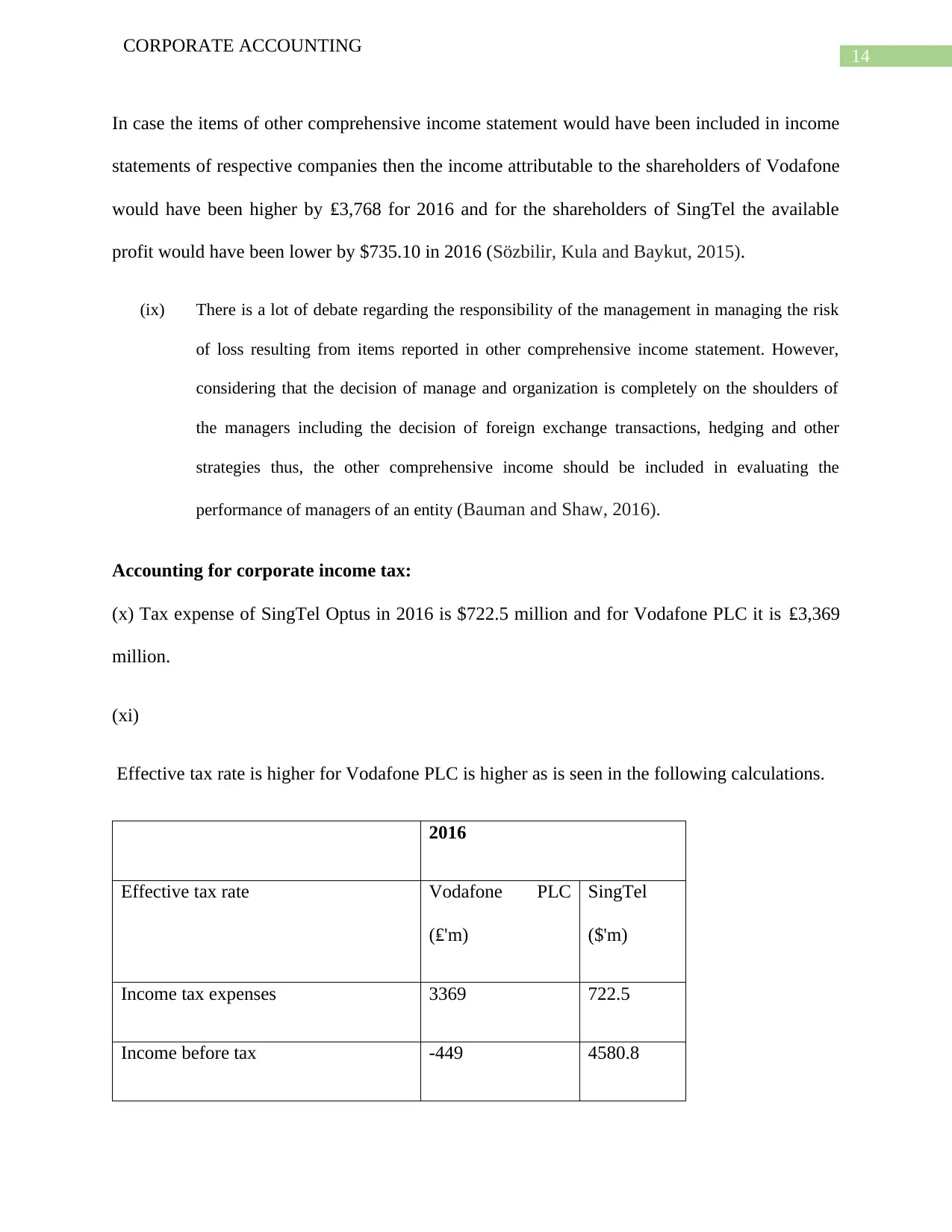
14
CORPORATE ACCOUNTING
In case the items of other comprehensive income statement would have been included in income
statements of respective companies then the income attributable to the shareholders of Vodafone
would have been higher by ₤3,768 for 2016 and for the shareholders of SingTel the available
profit would have been lower by $735.10 in 2016 (Sözbilir, Kula and Baykut, 2015).
(ix) There is a lot of debate regarding the responsibility of the management in managing the risk
of loss resulting from items reported in other comprehensive income statement. However,
considering that the decision of manage and organization is completely on the shoulders of
the managers including the decision of foreign exchange transactions, hedging and other
strategies thus, the other comprehensive income should be included in evaluating the
performance of managers of an entity (Bauman and Shaw, 2016).
Accounting for corporate income tax:
(x) Tax expense of SingTel Optus in 2016 is $722.5 million and for Vodafone PLC it is ₤3,369
million.
(xi)
Effective tax rate is higher for Vodafone PLC is higher as is seen in the following calculations.
2016
Effective tax rate Vodafone PLC
(₤'m)
SingTel
($'m)
Income tax expenses 3369 722.5
Income before tax -449 4580.8
CORPORATE ACCOUNTING
In case the items of other comprehensive income statement would have been included in income
statements of respective companies then the income attributable to the shareholders of Vodafone
would have been higher by ₤3,768 for 2016 and for the shareholders of SingTel the available
profit would have been lower by $735.10 in 2016 (Sözbilir, Kula and Baykut, 2015).
(ix) There is a lot of debate regarding the responsibility of the management in managing the risk
of loss resulting from items reported in other comprehensive income statement. However,
considering that the decision of manage and organization is completely on the shoulders of
the managers including the decision of foreign exchange transactions, hedging and other
strategies thus, the other comprehensive income should be included in evaluating the
performance of managers of an entity (Bauman and Shaw, 2016).
Accounting for corporate income tax:
(x) Tax expense of SingTel Optus in 2016 is $722.5 million and for Vodafone PLC it is ₤3,369
million.
(xi)
Effective tax rate is higher for Vodafone PLC is higher as is seen in the following calculations.
2016
Effective tax rate Vodafone PLC
(₤'m)
SingTel
($'m)
Income tax expenses 3369 722.5
Income before tax -449 4580.8
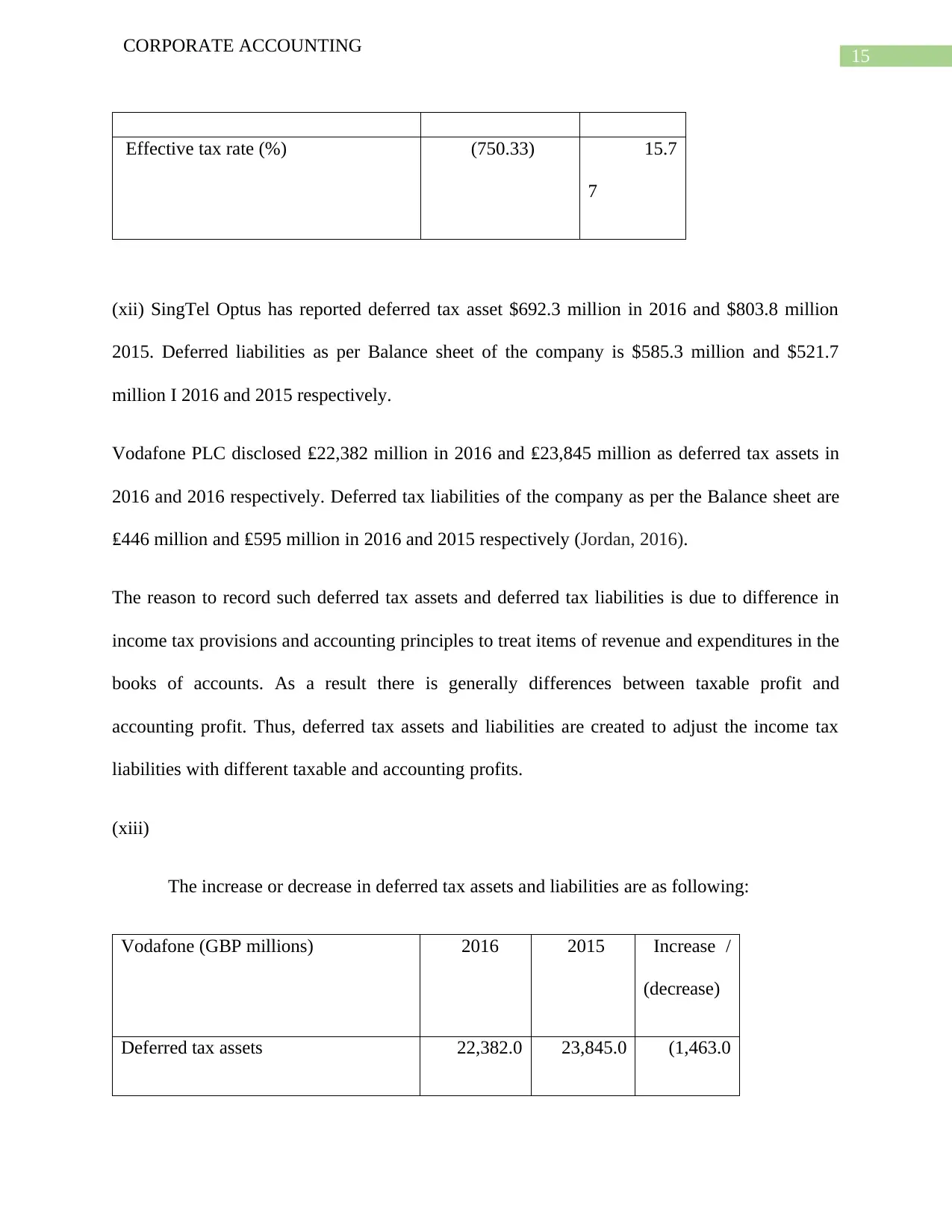
15
CORPORATE ACCOUNTING
Effective tax rate (%) (750.33) 15.7
7
(xii) SingTel Optus has reported deferred tax asset $692.3 million in 2016 and $803.8 million
2015. Deferred liabilities as per Balance sheet of the company is $585.3 million and $521.7
million I 2016 and 2015 respectively.
Vodafone PLC disclosed ₤22,382 million in 2016 and ₤23,845 million as deferred tax assets in
2016 and 2016 respectively. Deferred tax liabilities of the company as per the Balance sheet are
₤446 million and ₤595 million in 2016 and 2015 respectively (Jordan, 2016).
The reason to record such deferred tax assets and deferred tax liabilities is due to difference in
income tax provisions and accounting principles to treat items of revenue and expenditures in the
books of accounts. As a result there is generally differences between taxable profit and
accounting profit. Thus, deferred tax assets and liabilities are created to adjust the income tax
liabilities with different taxable and accounting profits.
(xiii)
The increase or decrease in deferred tax assets and liabilities are as following:
Vodafone (GBP millions) 2016 2015 Increase /
(decrease)
Deferred tax assets 22,382.0 23,845.0 (1,463.0
CORPORATE ACCOUNTING
Effective tax rate (%) (750.33) 15.7
7
(xii) SingTel Optus has reported deferred tax asset $692.3 million in 2016 and $803.8 million
2015. Deferred liabilities as per Balance sheet of the company is $585.3 million and $521.7
million I 2016 and 2015 respectively.
Vodafone PLC disclosed ₤22,382 million in 2016 and ₤23,845 million as deferred tax assets in
2016 and 2016 respectively. Deferred tax liabilities of the company as per the Balance sheet are
₤446 million and ₤595 million in 2016 and 2015 respectively (Jordan, 2016).
The reason to record such deferred tax assets and deferred tax liabilities is due to difference in
income tax provisions and accounting principles to treat items of revenue and expenditures in the
books of accounts. As a result there is generally differences between taxable profit and
accounting profit. Thus, deferred tax assets and liabilities are created to adjust the income tax
liabilities with different taxable and accounting profits.
(xiii)
The increase or decrease in deferred tax assets and liabilities are as following:
Vodafone (GBP millions) 2016 2015 Increase /
(decrease)
Deferred tax assets 22,382.0 23,845.0 (1,463.0
Secure Best Marks with AI Grader
Need help grading? Try our AI Grader for instant feedback on your assignments.
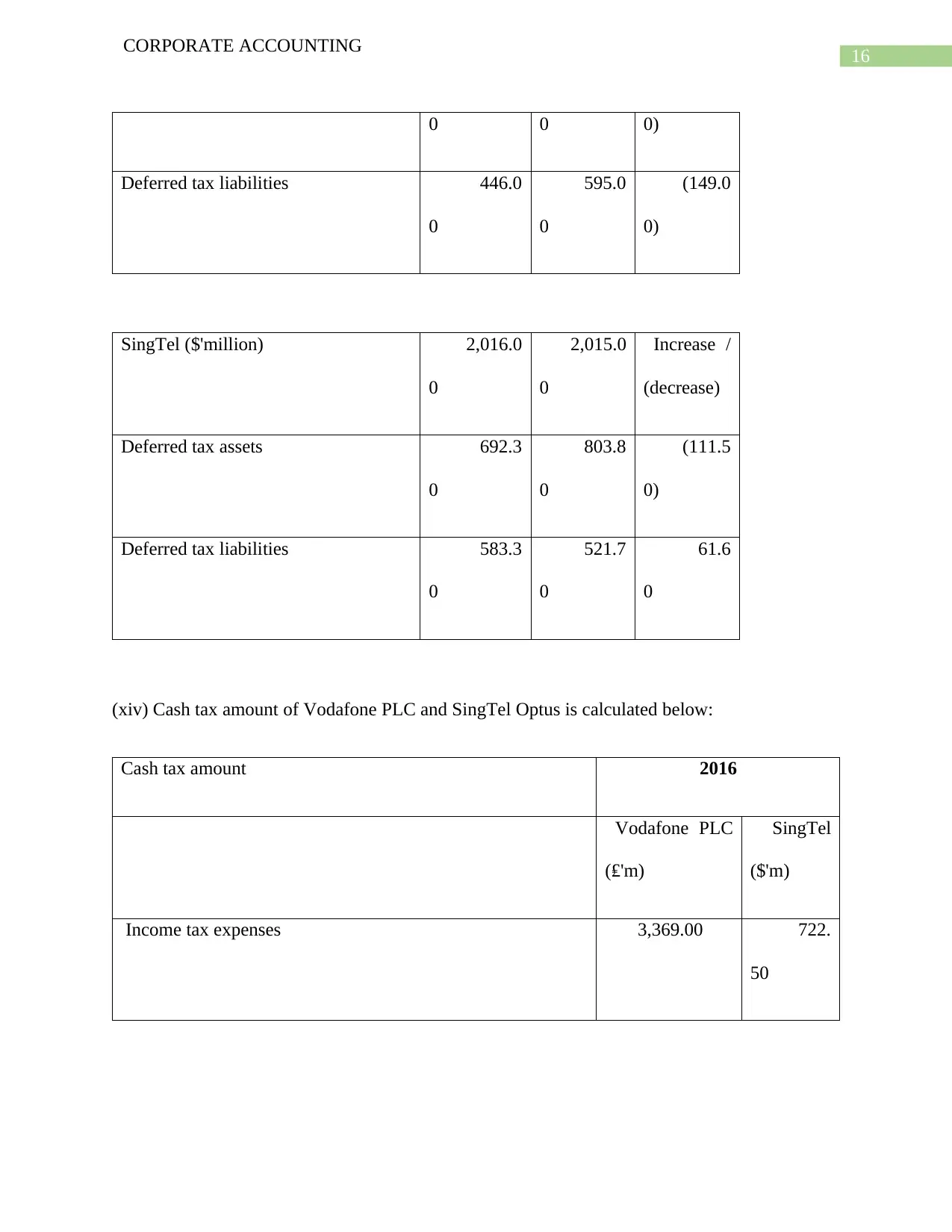
16
CORPORATE ACCOUNTING
0 0 0)
Deferred tax liabilities 446.0
0
595.0
0
(149.0
0)
SingTel ($'million) 2,016.0
0
2,015.0
0
Increase /
(decrease)
Deferred tax assets 692.3
0
803.8
0
(111.5
0)
Deferred tax liabilities 583.3
0
521.7
0
61.6
0
(xiv) Cash tax amount of Vodafone PLC and SingTel Optus is calculated below:
Cash tax amount 2016
Vodafone PLC
(₤'m)
SingTel
($'m)
Income tax expenses 3,369.00 722.
50
CORPORATE ACCOUNTING
0 0 0)
Deferred tax liabilities 446.0
0
595.0
0
(149.0
0)
SingTel ($'million) 2,016.0
0
2,015.0
0
Increase /
(decrease)
Deferred tax assets 692.3
0
803.8
0
(111.5
0)
Deferred tax liabilities 583.3
0
521.7
0
61.6
0
(xiv) Cash tax amount of Vodafone PLC and SingTel Optus is calculated below:
Cash tax amount 2016
Vodafone PLC
(₤'m)
SingTel
($'m)
Income tax expenses 3,369.00 722.
50
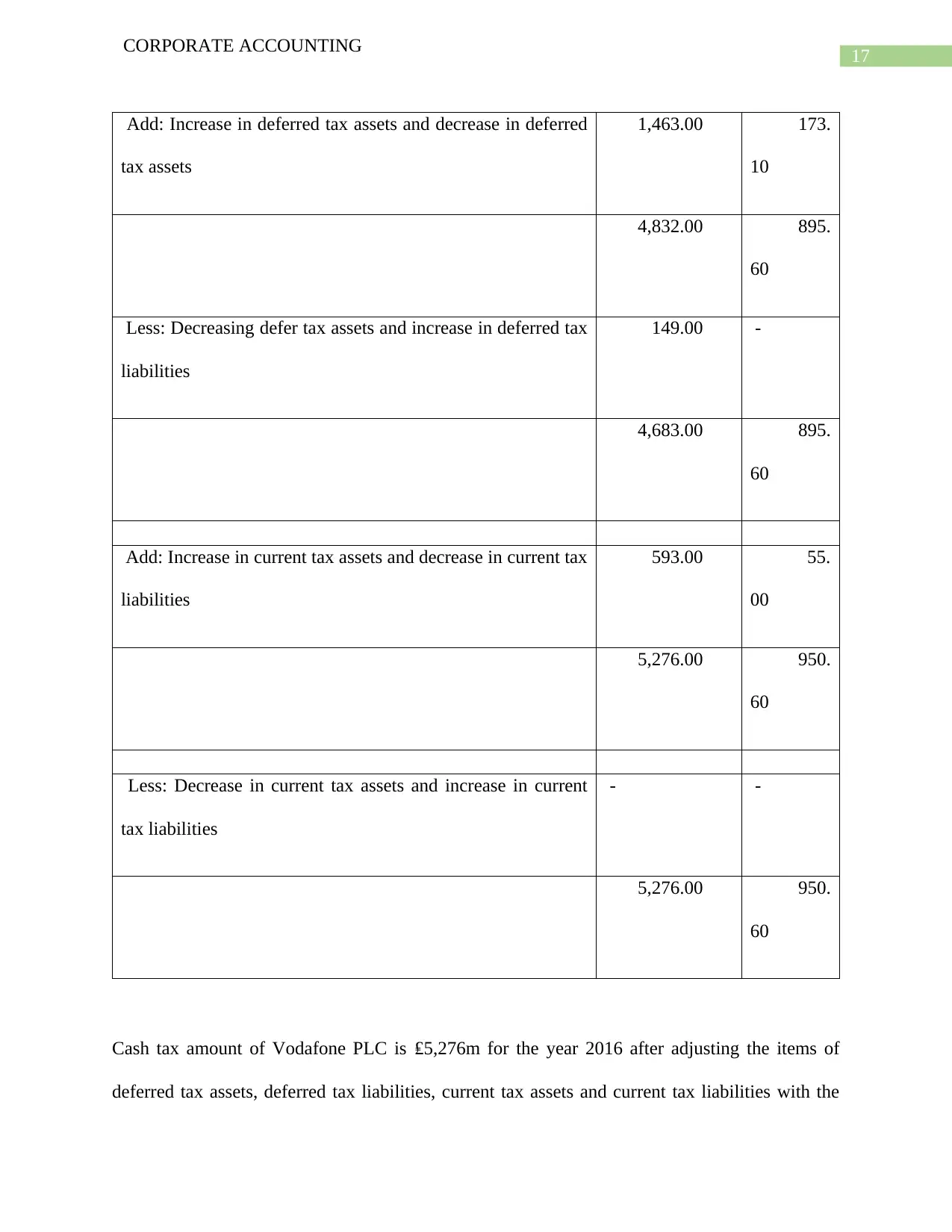
17
CORPORATE ACCOUNTING
Add: Increase in deferred tax assets and decrease in deferred
tax assets
1,463.00 173.
10
4,832.00 895.
60
Less: Decreasing defer tax assets and increase in deferred tax
liabilities
149.00 -
4,683.00 895.
60
Add: Increase in current tax assets and decrease in current tax
liabilities
593.00 55.
00
5,276.00 950.
60
Less: Decrease in current tax assets and increase in current
tax liabilities
- -
5,276.00 950.
60
Cash tax amount of Vodafone PLC is ₤5,276m for the year 2016 after adjusting the items of
deferred tax assets, deferred tax liabilities, current tax assets and current tax liabilities with the
CORPORATE ACCOUNTING
Add: Increase in deferred tax assets and decrease in deferred
tax assets
1,463.00 173.
10
4,832.00 895.
60
Less: Decreasing defer tax assets and increase in deferred tax
liabilities
149.00 -
4,683.00 895.
60
Add: Increase in current tax assets and decrease in current tax
liabilities
593.00 55.
00
5,276.00 950.
60
Less: Decrease in current tax assets and increase in current
tax liabilities
- -
5,276.00 950.
60
Cash tax amount of Vodafone PLC is ₤5,276m for the year 2016 after adjusting the items of
deferred tax assets, deferred tax liabilities, current tax assets and current tax liabilities with the
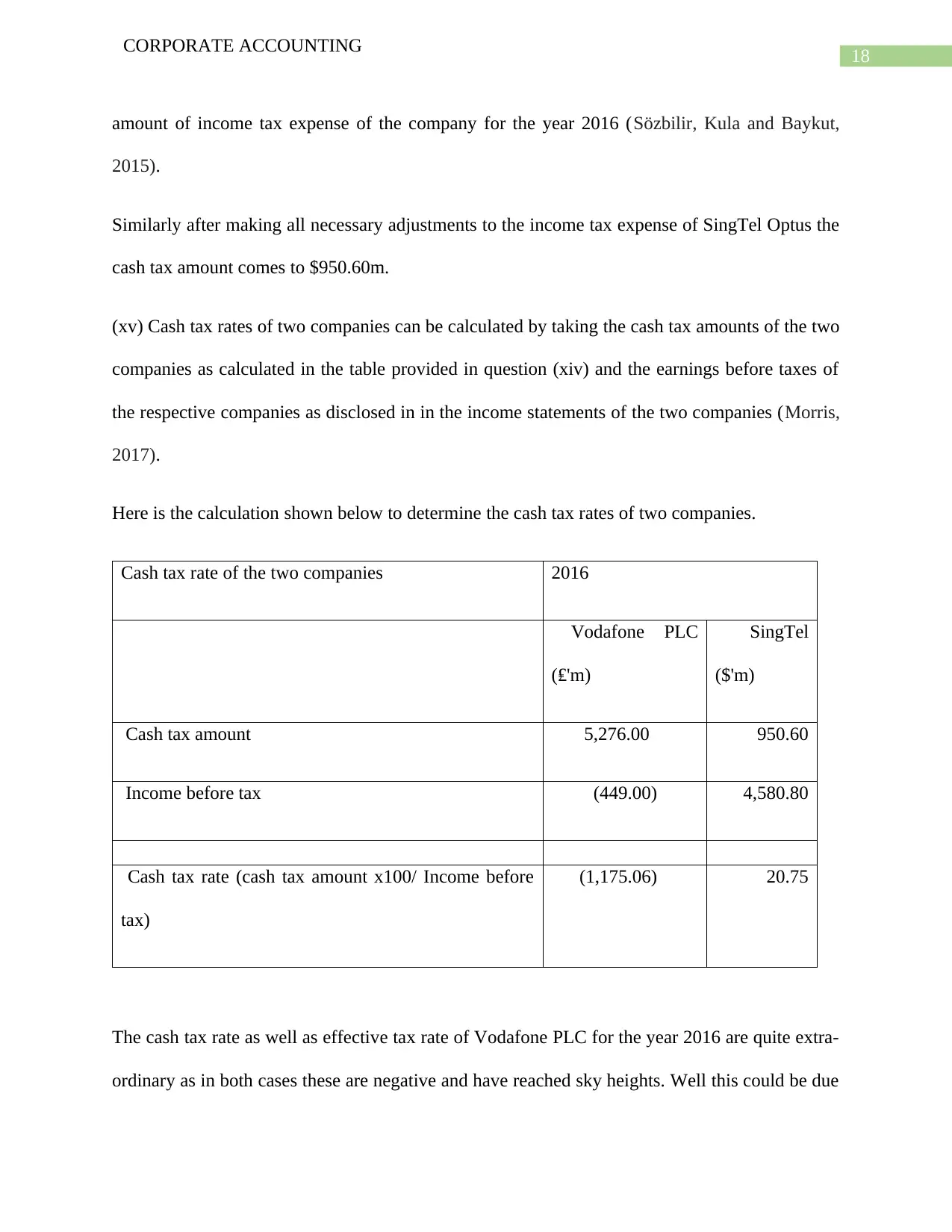
18
CORPORATE ACCOUNTING
amount of income tax expense of the company for the year 2016 (Sözbilir, Kula and Baykut,
2015).
Similarly after making all necessary adjustments to the income tax expense of SingTel Optus the
cash tax amount comes to $950.60m.
(xv) Cash tax rates of two companies can be calculated by taking the cash tax amounts of the two
companies as calculated in the table provided in question (xiv) and the earnings before taxes of
the respective companies as disclosed in in the income statements of the two companies (Morris,
2017).
Here is the calculation shown below to determine the cash tax rates of two companies.
Cash tax rate of the two companies 2016
Vodafone PLC
(₤'m)
SingTel
($'m)
Cash tax amount 5,276.00 950.60
Income before tax (449.00) 4,580.80
Cash tax rate (cash tax amount x100/ Income before
tax)
(1,175.06) 20.75
The cash tax rate as well as effective tax rate of Vodafone PLC for the year 2016 are quite extra-
ordinary as in both cases these are negative and have reached sky heights. Well this could be due
CORPORATE ACCOUNTING
amount of income tax expense of the company for the year 2016 (Sözbilir, Kula and Baykut,
2015).
Similarly after making all necessary adjustments to the income tax expense of SingTel Optus the
cash tax amount comes to $950.60m.
(xv) Cash tax rates of two companies can be calculated by taking the cash tax amounts of the two
companies as calculated in the table provided in question (xiv) and the earnings before taxes of
the respective companies as disclosed in in the income statements of the two companies (Morris,
2017).
Here is the calculation shown below to determine the cash tax rates of two companies.
Cash tax rate of the two companies 2016
Vodafone PLC
(₤'m)
SingTel
($'m)
Cash tax amount 5,276.00 950.60
Income before tax (449.00) 4,580.80
Cash tax rate (cash tax amount x100/ Income before
tax)
(1,175.06) 20.75
The cash tax rate as well as effective tax rate of Vodafone PLC for the year 2016 are quite extra-
ordinary as in both cases these are negative and have reached sky heights. Well this could be due
Paraphrase This Document
Need a fresh take? Get an instant paraphrase of this document with our AI Paraphraser
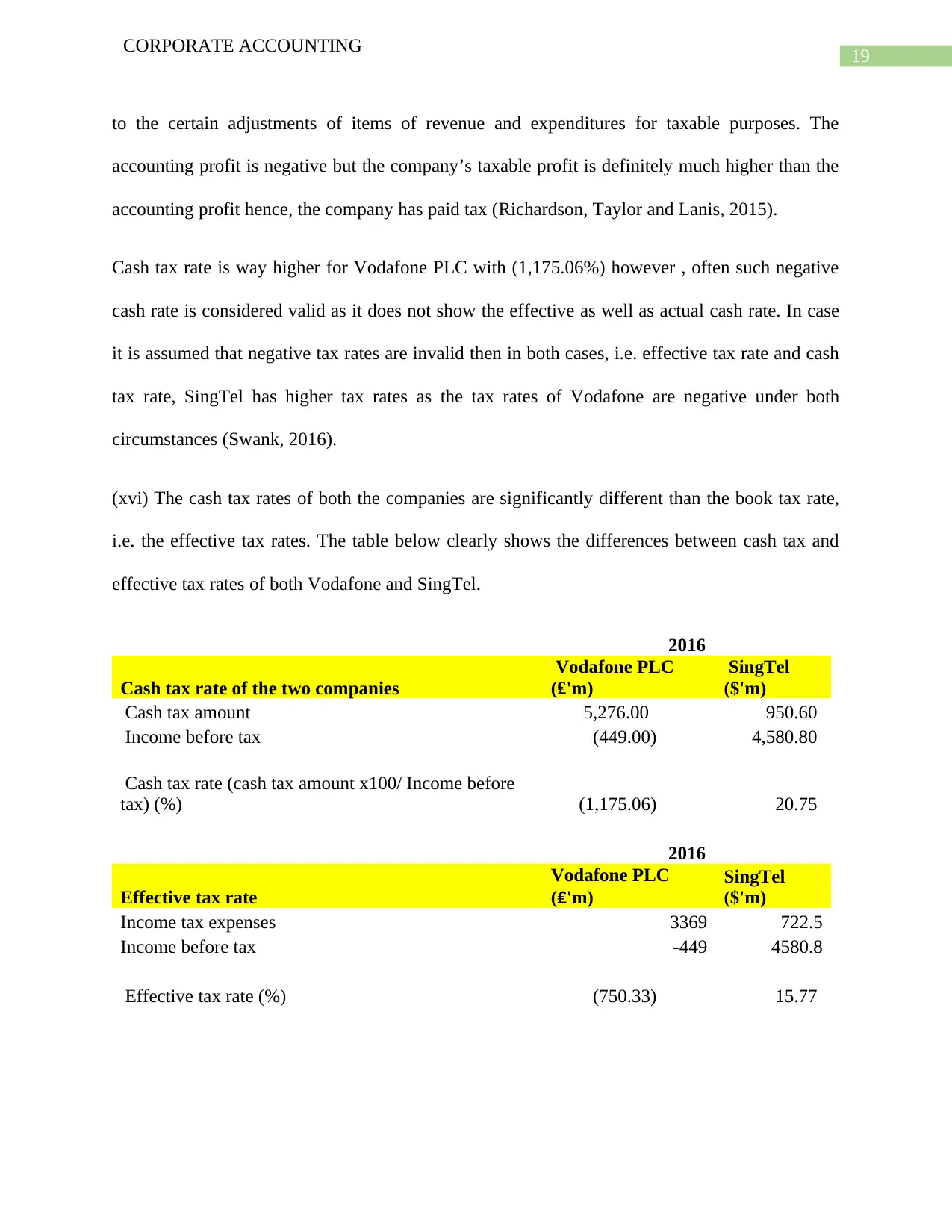
19
CORPORATE ACCOUNTING
to the certain adjustments of items of revenue and expenditures for taxable purposes. The
accounting profit is negative but the company’s taxable profit is definitely much higher than the
accounting profit hence, the company has paid tax (Richardson, Taylor and Lanis, 2015).
Cash tax rate is way higher for Vodafone PLC with (1,175.06%) however , often such negative
cash rate is considered valid as it does not show the effective as well as actual cash rate. In case
it is assumed that negative tax rates are invalid then in both cases, i.e. effective tax rate and cash
tax rate, SingTel has higher tax rates as the tax rates of Vodafone are negative under both
circumstances (Swank, 2016).
(xvi) The cash tax rates of both the companies are significantly different than the book tax rate,
i.e. the effective tax rates. The table below clearly shows the differences between cash tax and
effective tax rates of both Vodafone and SingTel.
2016
Cash tax rate of the two companies
Vodafone PLC
(₤'m)
SingTel
($'m)
Cash tax amount 5,276.00 950.60
Income before tax (449.00) 4,580.80
Cash tax rate (cash tax amount x100/ Income before
tax) (%) (1,175.06) 20.75
2016
Effective tax rate
Vodafone PLC
(₤'m)
SingTel
($'m)
Income tax expenses 3369 722.5
Income before tax -449 4580.8
Effective tax rate (%) (750.33) 15.77
CORPORATE ACCOUNTING
to the certain adjustments of items of revenue and expenditures for taxable purposes. The
accounting profit is negative but the company’s taxable profit is definitely much higher than the
accounting profit hence, the company has paid tax (Richardson, Taylor and Lanis, 2015).
Cash tax rate is way higher for Vodafone PLC with (1,175.06%) however , often such negative
cash rate is considered valid as it does not show the effective as well as actual cash rate. In case
it is assumed that negative tax rates are invalid then in both cases, i.e. effective tax rate and cash
tax rate, SingTel has higher tax rates as the tax rates of Vodafone are negative under both
circumstances (Swank, 2016).
(xvi) The cash tax rates of both the companies are significantly different than the book tax rate,
i.e. the effective tax rates. The table below clearly shows the differences between cash tax and
effective tax rates of both Vodafone and SingTel.
2016
Cash tax rate of the two companies
Vodafone PLC
(₤'m)
SingTel
($'m)
Cash tax amount 5,276.00 950.60
Income before tax (449.00) 4,580.80
Cash tax rate (cash tax amount x100/ Income before
tax) (%) (1,175.06) 20.75
2016
Effective tax rate
Vodafone PLC
(₤'m)
SingTel
($'m)
Income tax expenses 3369 722.5
Income before tax -449 4580.8
Effective tax rate (%) (750.33) 15.77
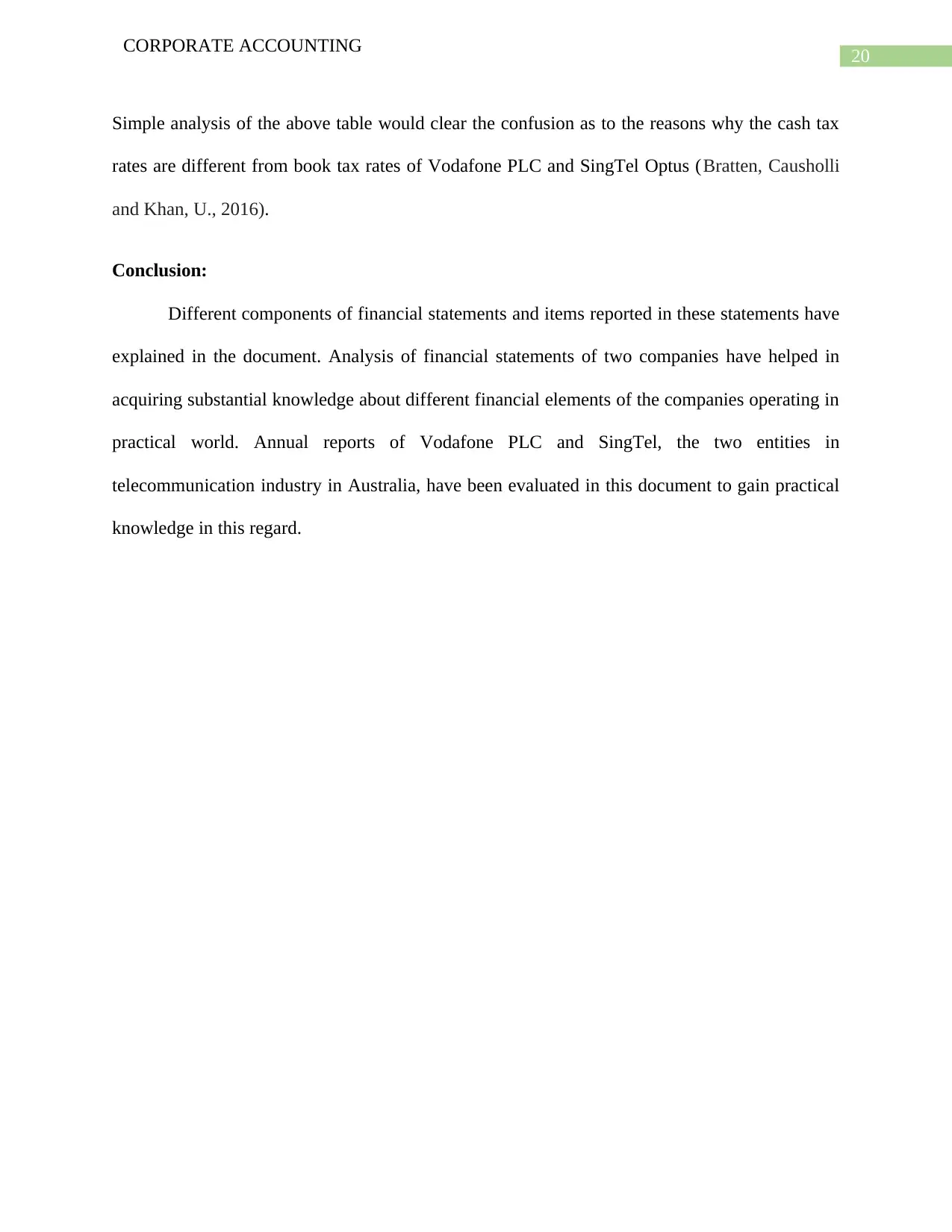
20
CORPORATE ACCOUNTING
Simple analysis of the above table would clear the confusion as to the reasons why the cash tax
rates are different from book tax rates of Vodafone PLC and SingTel Optus (Bratten, Causholli
and Khan, U., 2016).
Conclusion:
Different components of financial statements and items reported in these statements have
explained in the document. Analysis of financial statements of two companies have helped in
acquiring substantial knowledge about different financial elements of the companies operating in
practical world. Annual reports of Vodafone PLC and SingTel, the two entities in
telecommunication industry in Australia, have been evaluated in this document to gain practical
knowledge in this regard.
CORPORATE ACCOUNTING
Simple analysis of the above table would clear the confusion as to the reasons why the cash tax
rates are different from book tax rates of Vodafone PLC and SingTel Optus (Bratten, Causholli
and Khan, U., 2016).
Conclusion:
Different components of financial statements and items reported in these statements have
explained in the document. Analysis of financial statements of two companies have helped in
acquiring substantial knowledge about different financial elements of the companies operating in
practical world. Annual reports of Vodafone PLC and SingTel, the two entities in
telecommunication industry in Australia, have been evaluated in this document to gain practical
knowledge in this regard.
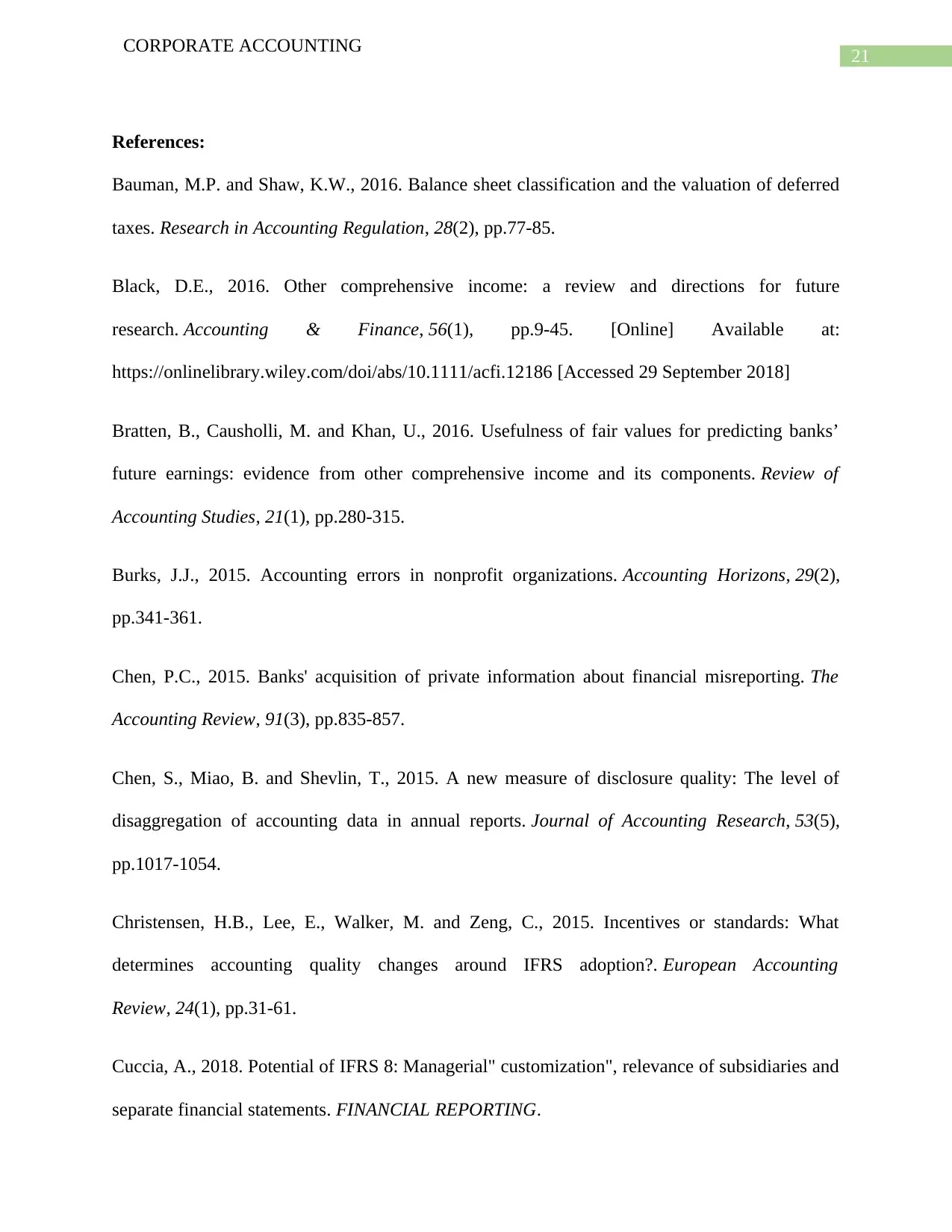
21
CORPORATE ACCOUNTING
References:
Bauman, M.P. and Shaw, K.W., 2016. Balance sheet classification and the valuation of deferred
taxes. Research in Accounting Regulation, 28(2), pp.77-85.
Black, D.E., 2016. Other comprehensive income: a review and directions for future
research. Accounting & Finance, 56(1), pp.9-45. [Online] Available at:
https://onlinelibrary.wiley.com/doi/abs/10.1111/acfi.12186 [Accessed 29 September 2018]
Bratten, B., Causholli, M. and Khan, U., 2016. Usefulness of fair values for predicting banks’
future earnings: evidence from other comprehensive income and its components. Review of
Accounting Studies, 21(1), pp.280-315.
Burks, J.J., 2015. Accounting errors in nonprofit organizations. Accounting Horizons, 29(2),
pp.341-361.
Chen, P.C., 2015. Banks' acquisition of private information about financial misreporting. The
Accounting Review, 91(3), pp.835-857.
Chen, S., Miao, B. and Shevlin, T., 2015. A new measure of disclosure quality: The level of
disaggregation of accounting data in annual reports. Journal of Accounting Research, 53(5),
pp.1017-1054.
Christensen, H.B., Lee, E., Walker, M. and Zeng, C., 2015. Incentives or standards: What
determines accounting quality changes around IFRS adoption?. European Accounting
Review, 24(1), pp.31-61.
Cuccia, A., 2018. Potential of IFRS 8: Managerial" customization", relevance of subsidiaries and
separate financial statements. FINANCIAL REPORTING.
CORPORATE ACCOUNTING
References:
Bauman, M.P. and Shaw, K.W., 2016. Balance sheet classification and the valuation of deferred
taxes. Research in Accounting Regulation, 28(2), pp.77-85.
Black, D.E., 2016. Other comprehensive income: a review and directions for future
research. Accounting & Finance, 56(1), pp.9-45. [Online] Available at:
https://onlinelibrary.wiley.com/doi/abs/10.1111/acfi.12186 [Accessed 29 September 2018]
Bratten, B., Causholli, M. and Khan, U., 2016. Usefulness of fair values for predicting banks’
future earnings: evidence from other comprehensive income and its components. Review of
Accounting Studies, 21(1), pp.280-315.
Burks, J.J., 2015. Accounting errors in nonprofit organizations. Accounting Horizons, 29(2),
pp.341-361.
Chen, P.C., 2015. Banks' acquisition of private information about financial misreporting. The
Accounting Review, 91(3), pp.835-857.
Chen, S., Miao, B. and Shevlin, T., 2015. A new measure of disclosure quality: The level of
disaggregation of accounting data in annual reports. Journal of Accounting Research, 53(5),
pp.1017-1054.
Christensen, H.B., Lee, E., Walker, M. and Zeng, C., 2015. Incentives or standards: What
determines accounting quality changes around IFRS adoption?. European Accounting
Review, 24(1), pp.31-61.
Cuccia, A., 2018. Potential of IFRS 8: Managerial" customization", relevance of subsidiaries and
separate financial statements. FINANCIAL REPORTING.
Secure Best Marks with AI Grader
Need help grading? Try our AI Grader for instant feedback on your assignments.
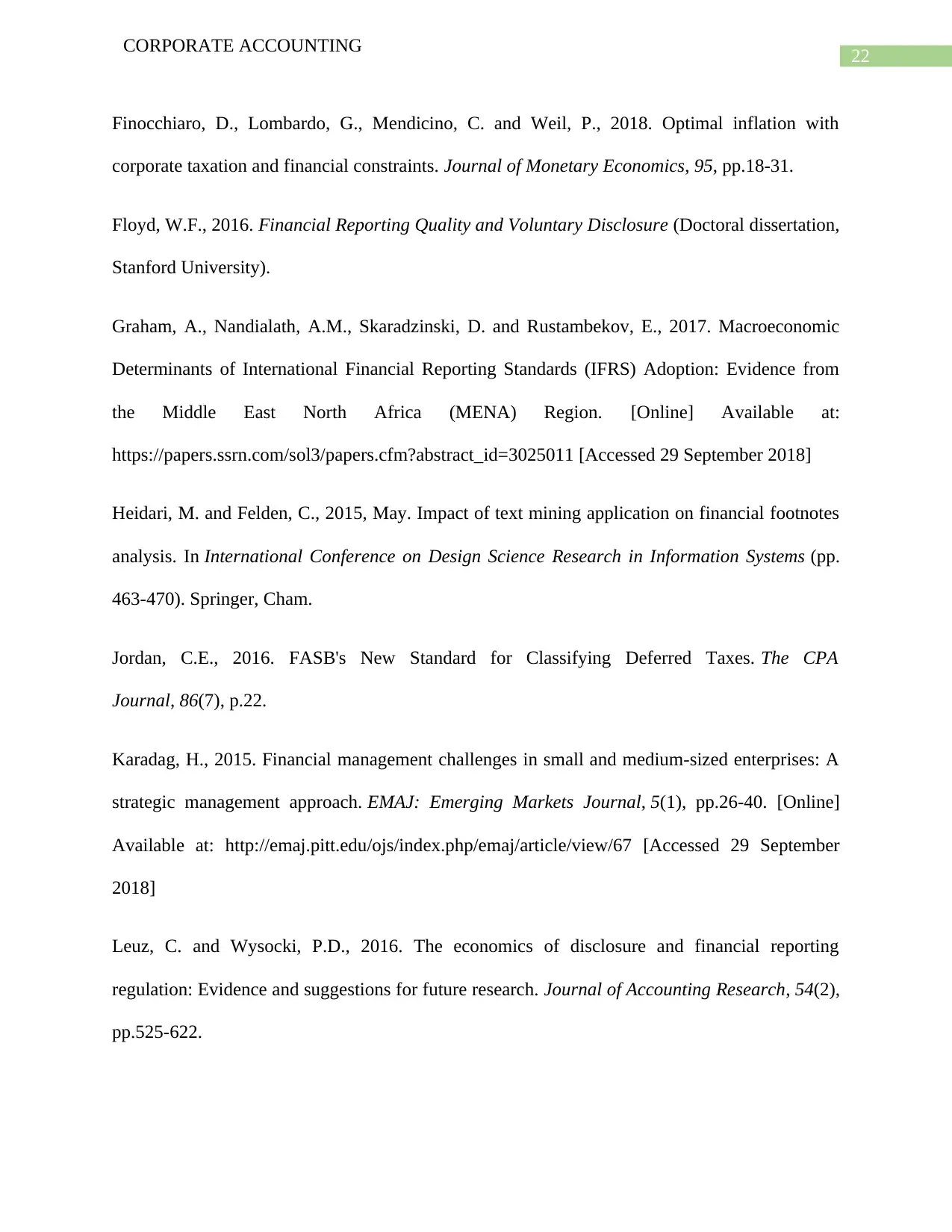
22
CORPORATE ACCOUNTING
Finocchiaro, D., Lombardo, G., Mendicino, C. and Weil, P., 2018. Optimal inflation with
corporate taxation and financial constraints. Journal of Monetary Economics, 95, pp.18-31.
Floyd, W.F., 2016. Financial Reporting Quality and Voluntary Disclosure (Doctoral dissertation,
Stanford University).
Graham, A., Nandialath, A.M., Skaradzinski, D. and Rustambekov, E., 2017. Macroeconomic
Determinants of International Financial Reporting Standards (IFRS) Adoption: Evidence from
the Middle East North Africa (MENA) Region. [Online] Available at:
https://papers.ssrn.com/sol3/papers.cfm?abstract_id=3025011 [Accessed 29 September 2018]
Heidari, M. and Felden, C., 2015, May. Impact of text mining application on financial footnotes
analysis. In International Conference on Design Science Research in Information Systems (pp.
463-470). Springer, Cham.
Jordan, C.E., 2016. FASB's New Standard for Classifying Deferred Taxes. The CPA
Journal, 86(7), p.22.
Karadag, H., 2015. Financial management challenges in small and medium-sized enterprises: A
strategic management approach. EMAJ: Emerging Markets Journal, 5(1), pp.26-40. [Online]
Available at: http://emaj.pitt.edu/ojs/index.php/emaj/article/view/67 [Accessed 29 September
2018]
Leuz, C. and Wysocki, P.D., 2016. The economics of disclosure and financial reporting
regulation: Evidence and suggestions for future research. Journal of Accounting Research, 54(2),
pp.525-622.
CORPORATE ACCOUNTING
Finocchiaro, D., Lombardo, G., Mendicino, C. and Weil, P., 2018. Optimal inflation with
corporate taxation and financial constraints. Journal of Monetary Economics, 95, pp.18-31.
Floyd, W.F., 2016. Financial Reporting Quality and Voluntary Disclosure (Doctoral dissertation,
Stanford University).
Graham, A., Nandialath, A.M., Skaradzinski, D. and Rustambekov, E., 2017. Macroeconomic
Determinants of International Financial Reporting Standards (IFRS) Adoption: Evidence from
the Middle East North Africa (MENA) Region. [Online] Available at:
https://papers.ssrn.com/sol3/papers.cfm?abstract_id=3025011 [Accessed 29 September 2018]
Heidari, M. and Felden, C., 2015, May. Impact of text mining application on financial footnotes
analysis. In International Conference on Design Science Research in Information Systems (pp.
463-470). Springer, Cham.
Jordan, C.E., 2016. FASB's New Standard for Classifying Deferred Taxes. The CPA
Journal, 86(7), p.22.
Karadag, H., 2015. Financial management challenges in small and medium-sized enterprises: A
strategic management approach. EMAJ: Emerging Markets Journal, 5(1), pp.26-40. [Online]
Available at: http://emaj.pitt.edu/ojs/index.php/emaj/article/view/67 [Accessed 29 September
2018]
Leuz, C. and Wysocki, P.D., 2016. The economics of disclosure and financial reporting
regulation: Evidence and suggestions for future research. Journal of Accounting Research, 54(2),
pp.525-622.
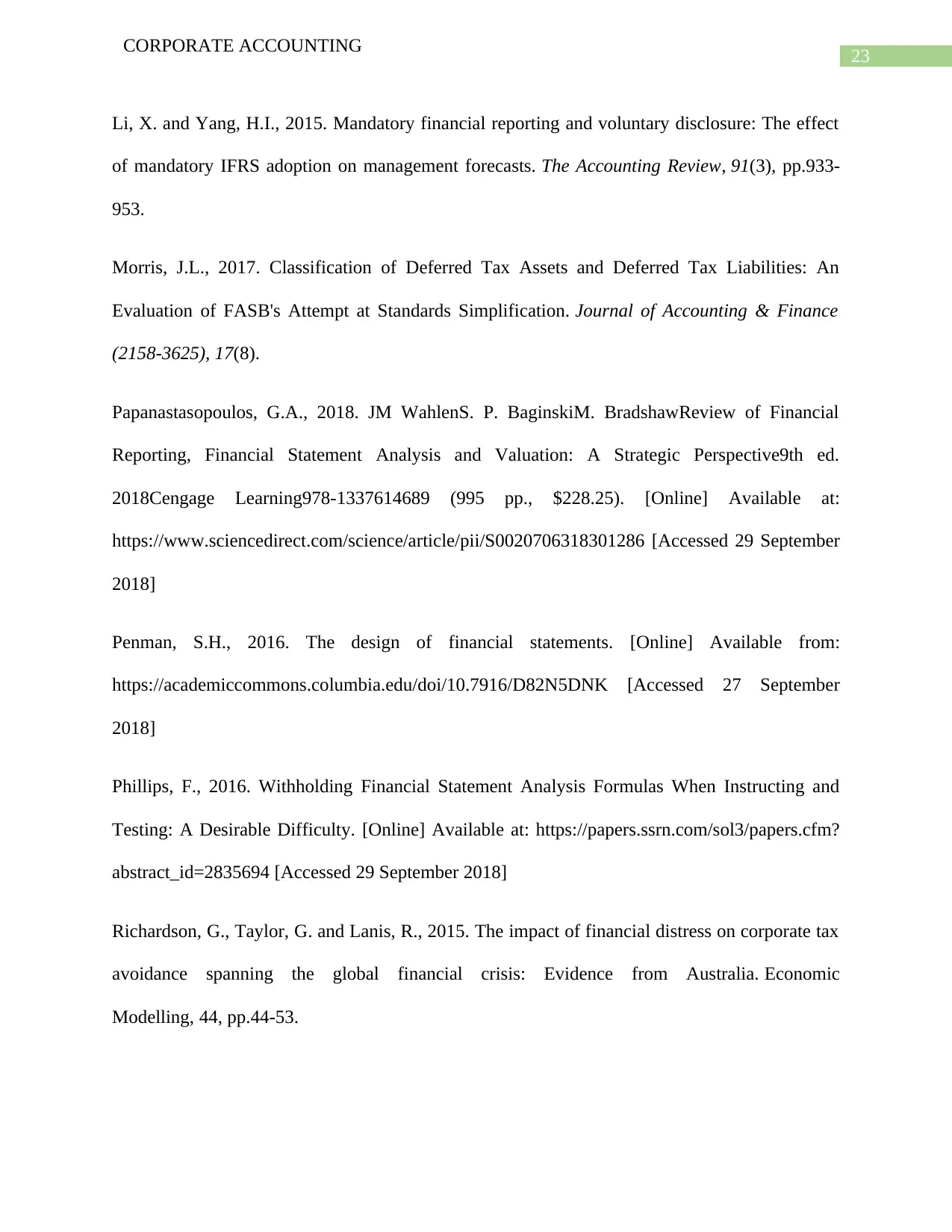
23
CORPORATE ACCOUNTING
Li, X. and Yang, H.I., 2015. Mandatory financial reporting and voluntary disclosure: The effect
of mandatory IFRS adoption on management forecasts. The Accounting Review, 91(3), pp.933-
953.
Morris, J.L., 2017. Classification of Deferred Tax Assets and Deferred Tax Liabilities: An
Evaluation of FASB's Attempt at Standards Simplification. Journal of Accounting & Finance
(2158-3625), 17(8).
Papanastasopoulos, G.A., 2018. JM WahlenS. P. BaginskiM. BradshawReview of Financial
Reporting, Financial Statement Analysis and Valuation: A Strategic Perspective9th ed.
2018Cengage Learning978-1337614689 (995 pp., $228.25). [Online] Available at:
https://www.sciencedirect.com/science/article/pii/S0020706318301286 [Accessed 29 September
2018]
Penman, S.H., 2016. The design of financial statements. [Online] Available from:
https://academiccommons.columbia.edu/doi/10.7916/D82N5DNK [Accessed 27 September
2018]
Phillips, F., 2016. Withholding Financial Statement Analysis Formulas When Instructing and
Testing: A Desirable Difficulty. [Online] Available at: https://papers.ssrn.com/sol3/papers.cfm?
abstract_id=2835694 [Accessed 29 September 2018]
Richardson, G., Taylor, G. and Lanis, R., 2015. The impact of financial distress on corporate tax
avoidance spanning the global financial crisis: Evidence from Australia. Economic
Modelling, 44, pp.44-53.
CORPORATE ACCOUNTING
Li, X. and Yang, H.I., 2015. Mandatory financial reporting and voluntary disclosure: The effect
of mandatory IFRS adoption on management forecasts. The Accounting Review, 91(3), pp.933-
953.
Morris, J.L., 2017. Classification of Deferred Tax Assets and Deferred Tax Liabilities: An
Evaluation of FASB's Attempt at Standards Simplification. Journal of Accounting & Finance
(2158-3625), 17(8).
Papanastasopoulos, G.A., 2018. JM WahlenS. P. BaginskiM. BradshawReview of Financial
Reporting, Financial Statement Analysis and Valuation: A Strategic Perspective9th ed.
2018Cengage Learning978-1337614689 (995 pp., $228.25). [Online] Available at:
https://www.sciencedirect.com/science/article/pii/S0020706318301286 [Accessed 29 September
2018]
Penman, S.H., 2016. The design of financial statements. [Online] Available from:
https://academiccommons.columbia.edu/doi/10.7916/D82N5DNK [Accessed 27 September
2018]
Phillips, F., 2016. Withholding Financial Statement Analysis Formulas When Instructing and
Testing: A Desirable Difficulty. [Online] Available at: https://papers.ssrn.com/sol3/papers.cfm?
abstract_id=2835694 [Accessed 29 September 2018]
Richardson, G., Taylor, G. and Lanis, R., 2015. The impact of financial distress on corporate tax
avoidance spanning the global financial crisis: Evidence from Australia. Economic
Modelling, 44, pp.44-53.
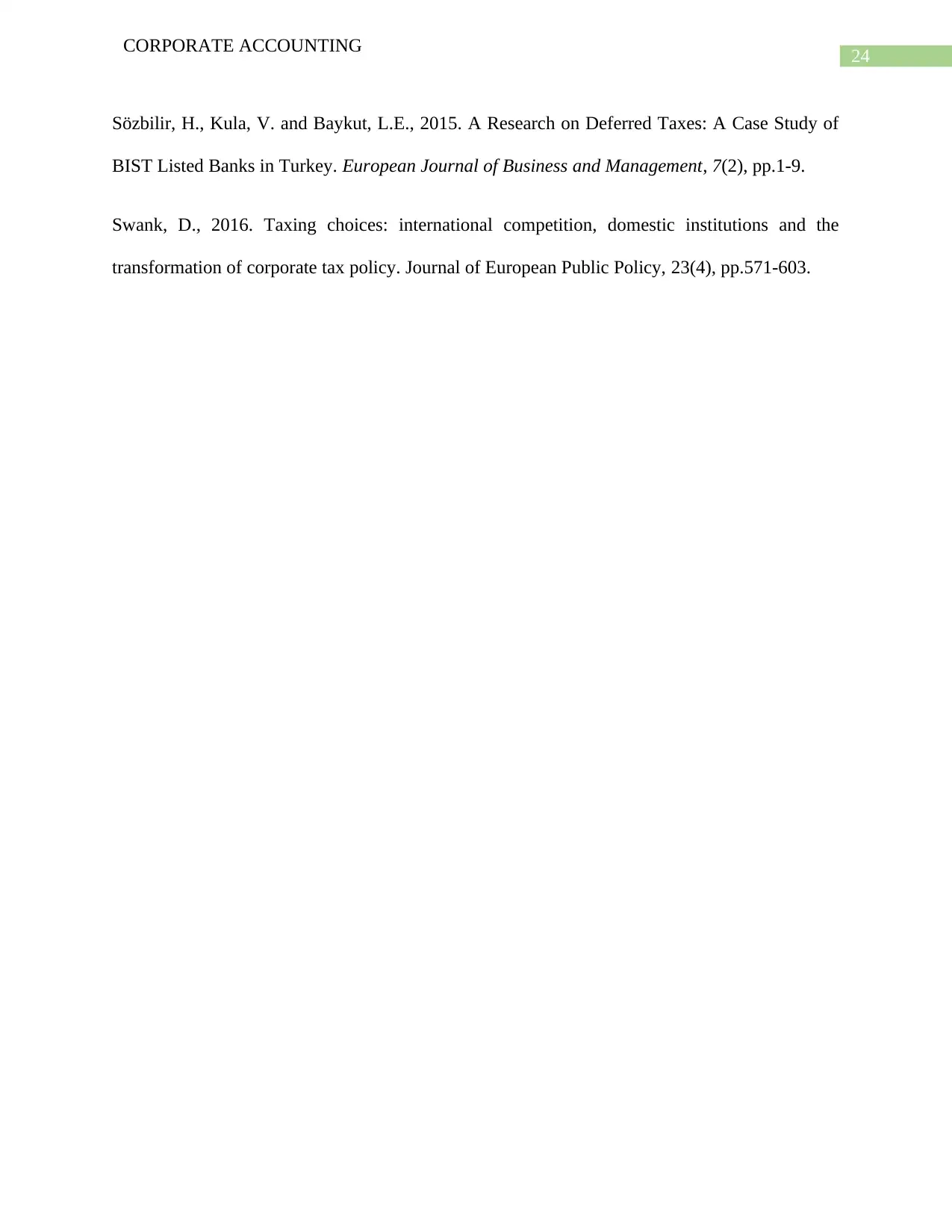
24
CORPORATE ACCOUNTING
Sözbilir, H., Kula, V. and Baykut, L.E., 2015. A Research on Deferred Taxes: A Case Study of
BIST Listed Banks in Turkey. European Journal of Business and Management, 7(2), pp.1-9.
Swank, D., 2016. Taxing choices: international competition, domestic institutions and the
transformation of corporate tax policy. Journal of European Public Policy, 23(4), pp.571-603.
CORPORATE ACCOUNTING
Sözbilir, H., Kula, V. and Baykut, L.E., 2015. A Research on Deferred Taxes: A Case Study of
BIST Listed Banks in Turkey. European Journal of Business and Management, 7(2), pp.1-9.
Swank, D., 2016. Taxing choices: international competition, domestic institutions and the
transformation of corporate tax policy. Journal of European Public Policy, 23(4), pp.571-603.
1 out of 25
Related Documents
Your All-in-One AI-Powered Toolkit for Academic Success.
+13062052269
info@desklib.com
Available 24*7 on WhatsApp / Email
![[object Object]](/_next/static/media/star-bottom.7253800d.svg)
Unlock your academic potential
© 2024 | Zucol Services PVT LTD | All rights reserved.





